History from 5 Million BC to 1500 AD
Masters Degree Program in History
|
5 Million BC - 10,000 BC Stone Age/Ice Age 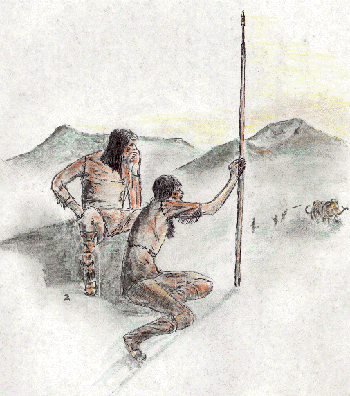 Anthropologists designate early human cultures by their tools. The earliest cultural period, the Paleolithic, dates from the first use of stone tools. During this long span, people were hunters, fishers, and gatherers but not producers of food. They learned to make and use increasingly sophisticated tools of stone and perishable material like wood, they learned to make and control fire, and they acquired language and the ability to use it to pass on what they had learned. These early humans, dependent on nature for food and vulnerable to wild beasts and natural disasters, may have developed responses to the world rooted in fear of the unknown of the uncertainties of human life or the overpowering forces of nature. Religious and magical beliefs and practices may have emerged in an effort to coerce the superhuman forces thought to animate or direct the natural world. Evidence of religious faith and practice, as well as of magic, goes back nearly one hundred thousand years. The sense that there is more to the world than meets the eye, in other words, the religious response to the world seems to be as old as humankind. 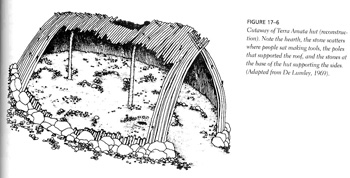 Paleolithic society was probably characterized by a division of labor by sex. Men most likely hunted, fished, and fought other families, clans and tribes. Women, less mobile because of childbearing, most likely gathered nuts, berries, and wild grains, wove baskets, and made clothing. Women gathering food probably discovered how to plant and care for seeds, knowledge that eventually led to agriculture and the Neolithic revolution. Link: Nutrition in the Paleolithic Age 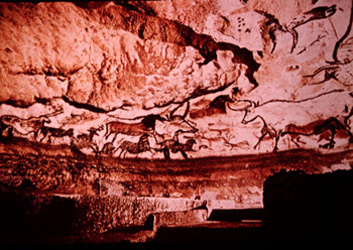 Hall of Bulls, Lascaux Caves Dated between 28,000 and 10,000 BC, the paintings on cave walls found near Lascaux, France represent the earliest surviving examples of the artistic expression of early people. Using the natural rock contours that suggest the volume of the animals, these 'primitive' people of the Paleolithic (Old Stone Age) painted evocative and startlingly accurate representations of the animals that were such an important part of their lives.
10,000 BC - 3300 BC Middle Stone Age (Agricultural Revolution) 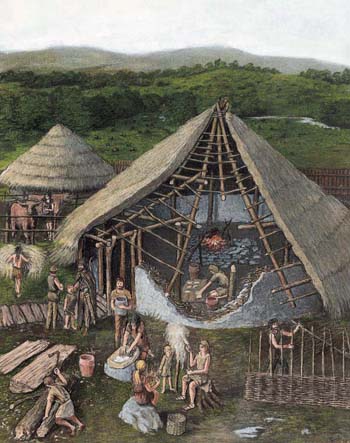 Ten thousand years ago a few Paleolithic societies made the revolutionary shift to agriculture in what we now call the Near East. They shifted from a hunter-gatherer way of life to a settled agricultural one. Neolihtic people domesticated animals as well as plants. They invented pottery, allowing them to store surplus liquids. They learned to weave cloth from flax and wool. And to give their crops the constant care they required from planting to harvest, Neolithic people built permanent buildings, usually in clusters near the best fields. The shift from food gathering to food production may not have been associated with an immediate change in population, but over time in the regions where agriculture and animal husbandry appeared, the number of human beings grew at an unprecedented rate. The Neolithic revolution was a major step in human control of nature, and it was a vital precondition for the emergence of civilization. 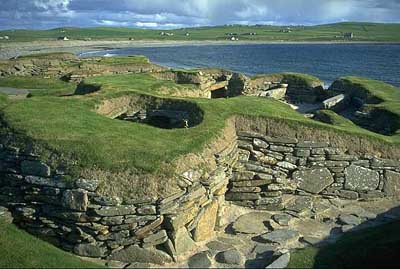 Skara Bae Link: YouTube A Neolithic settlement has been preserved at Skara Brae, in the Orkney islands off the northern coast of Scotland. This settlement was constructed of stone. A hugh prehistoric storm buried this seaside village under a layer of sand. Another storm brought it to light again in 1850. The ruins exposed a vivid picture of Neolithic life in the north. View the links provided on the earliest of villages. Keep in mind stonehenge and its purpose as you study the construction of Skara Brae. Link: Skara Bae The Neolithic agricultural revolution had far-reaching consequences. Once people settled in villages or towns, they built houses for protection and other structures for the storage of goods. As organized communities stored food and accumulated material goods, they began to engage in trade. People also began to specialize in certain crafts, and a division of labor developed. Pottery was made from clay and baked in a fire to make it hard. The pots were used for cooking and to store grains. In the course of the Neolithic Age, many of the food plants still in use today began to be cultivated. The Neolithic Revolution was truly a turning point in human history. 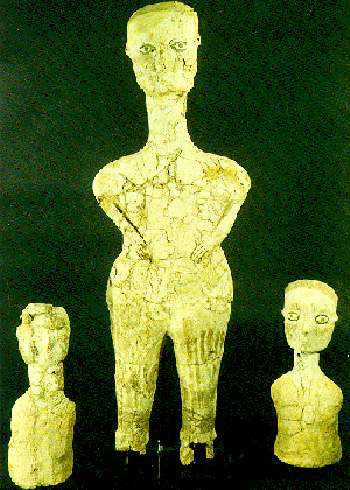
Neolithic Statues Ain Ghazal In Paleolithic art, man learned to abstract his world by making a picture of it. Paleolithic people sought to control it by capturing and holding its image. In the Neolithic period man made the giant leap toward the actual, concrete control of their environment by settling in fixed abodes and domesticating plants and animals. The wandering hunter settled down to organized community living in villages surrounded by cultivated fields. Link: Neolithic Warfare Link: Neolithic China 
Stonehenge, Salisbury Plain, Wiltshire, England. Link: Stonehenge Stonehenge seems to have been built in several phases around 2000BC. The mysterious structure, believed in the Middle Ages to have been the work of the magician Merlin, who spirited it from Ireland, or the work of a race of giants, comes in our own time to be thought of as an accurate calendar. Link: Beginning of Civilization
3300 BC The Bronze Age is Developing 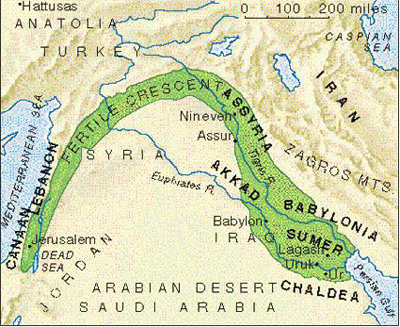 Ancient Mesopotamia At first, Neolithic settlements were hardly more than villages. But as their inhabitants mastered the art of farming, more complex human societies began to emerge. As wealth increased, these societies began to develop armies and to build walled cities. by the beginning of the Bronze Age, the concentration of larger numbers of people in the river valleys of Mesopotamia and Egypt was leading to a whole new pattern for human life. As human societies grew and developed greater complexity, a new form of human existence - called civilization - came into being. A civilization is a complex culture in which large numbers of human beings share a number of common elements. Historians have identified a number of basic characteristics of civilization, most of which were evident in ancient Mesopotamia and Egypt. These include ( 1) an urban revolution: cities became the focal points for political, economic, social, cultural, and religious development; ( 2) a distinct religious structure: the gods were deemed crucial to the community's success, and professional priestly classes, as stewards of the gods' property, regulated relations with the gods; (3) new political and military structures: an organized government bureaucracy arose to meet the administrative demands of the growing population while armies were organized to gain land and power; (4) a new social structure based on economic power: while kings and an upper class of priests, political leaders, and warriors dominated, there also existed a large group of free men (farmers, artisans, craftspeople) and at the very bottom, socially, a class of slaves; (5) the development of writing: kings, priests, merchants, and artisans used writing to keep records; and (6) new forms of significant artistic and intellectual activity: monumental architectural structures, usually religious, occupied a prominent place in urban environments.  Sumerian Tax tablet The initial shift from village to city and from prehistory to history took place in one of the most inhospitable environments, the southern desert of Mesopotamia (modern Iraq) known to the Greeks as the "Land Between the Rivers." There the arid climate confronted the peoples with the hard problem of farming with scant water supplies. In the east farmers learned to irrigate their land and later to drain it to prevent the buildup of salt in the soil. The origins of writing go back to the ninth millennium B.C., when Near eastern peoples used clay tablets for record keeping in connection with economic pursuits, reflection of the growing wealth of the Sumerians. For some time, writing remained purely pictographic, each symbol marked into the clay resembled the physical object it represented. These pictographs were a form of writing known as cuneiform from the Latin term for "wedge-shaped," used to describe the strokes of the stylus. Mesopotamian thought had a profound impact in theology and religion. The Sumerians originated many beliefs, and their successors added to them. The Mesopotamian's believed that many gods run the world, but they did not consider all gods and goddesses equal. Some deities had very important jobs, taking care of music, law, and victory. Mesopotamian gods lived their lives much as human being lived theirs. 3300 BC 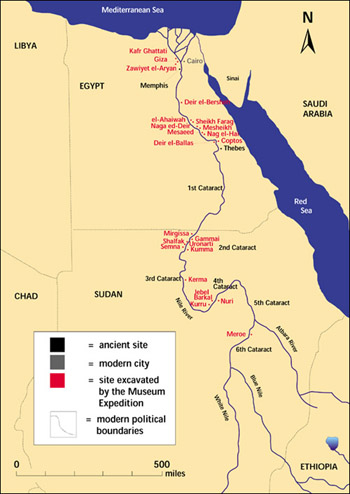 Ancient Egypt Early in Egyptian history unity was achieved and maintained. The Nile was an important factor in this early achievement of national unity, for it provided a first-class means of transportation up and downstream. A steady northern wind propelled ships sailing against the current and traffic moving in the opposite direction had the assistance of the flow of the river itself. Outside the delta the habitable land of Egypt does not extend more than 15 miles on either side of the Nile, and often much less, so military control of the river could be easily translated into control of Egypt itself. Beyond the advantages of good communication, Egypt was lucky to have defensible frontiers. To the east and west, fearsome deserts offered protection and reduced potential invasion routes to two easily defended passageways, the Gaza Strip to the northeast and the route from Libya through El Alamein in the west. Egypt was also blessed in other respects. The natural environment of the Nile valley made the practice of agriculture much less demanding than it was in Mesopotamia. Annually, the Nile flooded the river valley from desert wall to desert wall to a depth of 3 to 4 feet, leaving behind a fertile layer of mud as it receded. The flooding began in early June, and by October the river had returned to its normal channel, just in time for the winter planting of cereal crops - the reverse of the situation in Mesopotamia. The Pharaoh's Power: The challenge to the early pharaohs was how they were to maintain their rule over the vast land of Egypt. Pharaonic Egypt was over 750 miles long, and in its early years it contained a wide diversity of peoples and cultures. Egyptian unity and stability were not an accident of environment. They were instead created by the Egyptian people themselves, in particular of their gifted ruling class. What worked for Egypt in ancient times was a dictatorship of a god-king. In Egyptian belief, the sun rose daily and traveled across the sky to the western horizon, where it entered the underworld. From there, after fighting off the forces of chaos and disorder, it emerged the following morning with renewed strength and repeated its daily passage through the sky. Similarly, the Nile was thought to pass through a cycle of birth and death. For months it lay as a muddy stream between fields burned brown by the hot sun. Then, miraculously, it gathered force and swelled until it overflowed its banks and spread a great mantle of water over the dry countryside. Gradually shrinking, it left a rich deposit of silt from which the new crops sprang. The Egyptians believed that this orderly world had been brought into existence by the gods and fixed by them for all time, in the first moment of its creation. There was no evolution, no development, just repetition. The interworking of its parts and the balance of its elements were described by the term ma'at, which can be translated as "order," "justice," or "truth." The course of the stars, the sequence of day and night and the passage of all things from life to death were part of this universal, unchanging ma'at. The cosmos did not advance or retreat or develop; it repeated itself in an "eternal now." What lay outside this was exceptional, an aberration that had to be endured until the gods restored order. When it came to maintaining the ma'at of Egypt, the gods delegated one of their number, Horus, the son of Osiris, to be the guarantor of its balance and harmony. His function was to ensure the continuing existence and activity of the gods on earth by means of religious acts and to maintain the natural order such as the flow of the Nile and the fertility of the soil. His authority was neither political, social, nor economic, bu cosmic. He did not rule by the consent of the governed but by a decision of the gods. The pharaoh was charged by the gods with the care of Egypt, not as his private possession for his own personal enjoyment but in accordance with the original act of creation. In the words of one of the pharaohs, Merikare, he was the "shepherd of his people ... who spends the day caring for them." One of the earliest of the kings' insignia was the shepherd's crook. Link: Egyptian History Link: Egyptian Life Link: Ancient Egyptian Culture 3300 BC  An Egyptian king was considered no mere representative of the gods, but a god himself, on whom the lives, safety, and prosperity of his people depended. The land was his own personal possession, and the people his servants. Because he was the direct source of the law and justice, Egypt needed no law codes. Government was merely an aspect of religion, and religion dominated Egyptian life. The gods of Egypt took many forms: as animals, humans, and natural forces. In time, Re, the sun god, came to have a special and dominant place, but for centuries, there was little order in the Egyptian pantheon. The Egyptians had a rather clear idea of an afterlife. They buried their dead according to elaborate conventions, supplying the grave with things the departed would need for a pleasant life after death. At first only kings were thought to achieve eternal life; then nobles, and finally all Egyptians if properly embalmed and buried with the requisite spells, laid claim to immortality. Bodies were preserved as mummies. Tombs were beautifully decorated with paintings; offerings of food were regularly brought to the dead. Some royal tombs were provided with full-sized ships for the voyage to heaven. 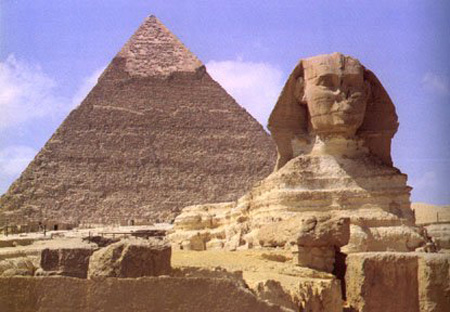 Nothing better illustrates the extent of royal power than the three great pyramids built as tombs by the kings (Pharaohs) of the Fourth Dynasty. The largest, that of Khufu, was originally 481 feet high and 756 feet long on each side. It was built of 2.3 million stone blocks averaging 2.5 tons each. The Greek historian Herodotus claimed that 100,000 men spent twenty years building it. The pyramids give evidence that the Egyptian kings controlled vast wealth, had the power to focus enormous human effort on a personal project, and possessed the confidence to undertake a project of such a long durance. Link: Pyramids 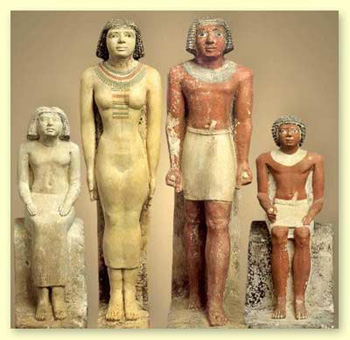 Ancient Egyptians had a very positive attitude toward daily life on earth and followed the advise of the wisdom literature, which suggested that people marry young and establish a home and family. Monogamy was the general rule, although a husband was allowed to keep additional wives if his first wife was childless. Pharaohs were entitled to harems; the queen, however, was acknowledged as the Great Wife, with a status higher than that of the other wives. The husband was master in the house, but wives were very much respected and in charge of the household and education of the children. From a book of wise sayings came this advise: "If you are a man of standing, you should found your household and love your wife as is fitting. Fill her belly; clothe her back. Ointment is the prescription for her body. Make her heart glad as long as you live. She is profitable field for her lord. You should not control with her at law, and keep her far from gaining control...Let her heart be soothed through what may accrue to you; it means keeping her long in your house." Women's property and inheritance remained in their hands, even in marriage. Although most careers and public offices were closed to women, some did operate businesses. Peasant women worked long hours in the fields and at numerous domestic tasks. Upper-class women could function as priestesses, and a few queens even became pharaohs. 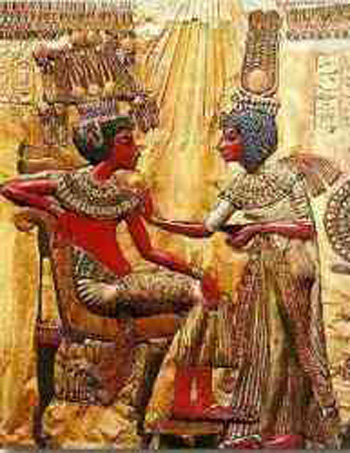 Marriages were arranged by parents. The primary concerns were family and property, and clearly the chief purpose of marriage was to produce children, especially sons. From the New Kingdom: Take to yourself a wife while you are a youth, that she may produce a son for you." Marriage could and did end in divorce, which was allowed, with compensation for the wife. Adultery, however, was strictly prohibited, and punishments were severe, especially for women, who could have their noses cut off or be burned at the stake. It wasn't necessary, but most marriages had a contract drawn up between the parties. The poorer classes probably did not do this because they probably had few possessions to consider and also the cost of a scribe would have been prohibitive. Marriage settlements were drawn up between a woman's father and her prospective husband, although many times the woman herself was part of the contract. The sole purpose of the contract was to establish the rights of both parties to maintenance and possessions during the marriage and after divorce if it should occur, very similar to today's prenuptial agreements. What is really fascinating is the equality women held with men in their rights to own, manage and receive property. If the marriage ended in divorce, the rights of the wife were equally protected. Generally, she was entitled to support from her husband, especially if she was rejected by him through no fault of her own. The amount might equal one third of the settlement or even more. If the bride ended up committing adultery (which was extremely frowned upon for both men and women), she still had certain rights to maintenance from her former husband. Monogamy, except for some of the higher classes and royalty, seemed to be the rule for most ancient Egyptian couples. Here's a standard marriage contract that was found among the numerous records left by the ancient Egyptians. It contained:
Link: Women in Ancient Egypt
 Like most ancient peoples, the Greeks were polytheists, and religion played an important part in their lives. A great part of Greek art and literature was closely connected with religion, as was the life of the "polis" in general. The gods were seen as behaving very much as mortal humans behaved, with all the traits of humans, except that they were superhuman in these as well as in their strength and immortality. On the other hand, Zeus, was seen as a source of human justice, and even the Olympians were understood to be subordinate to the Fates. Each "polis" had one of the Olympians as its guardian deity and worshipped the god in its own special way. The worship of these deities did not involve great emotion. Worshippers offered a god prayer, libations, and gifts in hopes of protection and favors. Greek religion offered no hope of immortality for the average human and little moral teaching. Most Greeks seem to have held to the common sense notion that justice lay in paying one's debts. They thought that civic virtue consisted of worshipping the state deities in the traditional way, performing required public services and fighting in defense of the state. To them, private morality meant to do good to one's friends and harm to one's enemies. The oracle was the most important that helped satisfy human craving for a clue to the future. The priests of Apollo preached moderation, their advise was exemplified in the two famous sayings identified with Apollo: "know thyself" and "Nothing in excess." Humans need self control. Its opposite is arrogance, which is brought on by excessive wealth or good fortune. Arrogance leads to moral blindness and finally to divine vengeance. This theme of moderation and dire consequences of its absence was central to Greek popular morality and appears frequently in Greek literature. 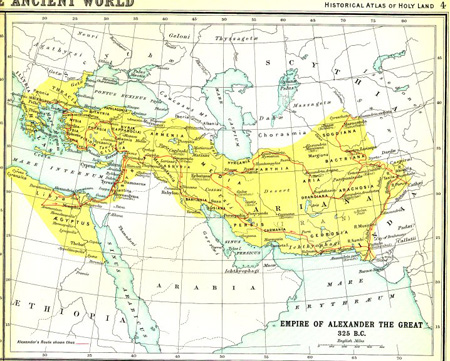 Alexander is one of the most puzzling great figures in history. Historians relying on the same sources give vastly different pictures of him. Some portray him as an idealistic visionary and others as a ruthless Machiavellian. No doubt he was a great military leader - a master of strategy and tactics, fighting in every kind of terrain and facing every kind of opponent. Alexander was a brave and even reckless fighter who was quite willing to lead his men into battle and risk his own life. His example inspired his troops to follow him into unknown lands and difficult situations. We know that he sought to imitate Achilles, the warrior-hero of Homer's Iliad, who was an ideal still important in Greek culture. Alexander kept a copy of the Iliad - and a dagger - under his pillow. He also claimed to be descended from Heracles, the Greek hero who came to be worshiped as a god. Alexander also aspired to divine honors; as pharaoh of Egypt, he became a living god according to Egyptian tradition and at one point even sent instructions to the Greek cities to "vote him a god." 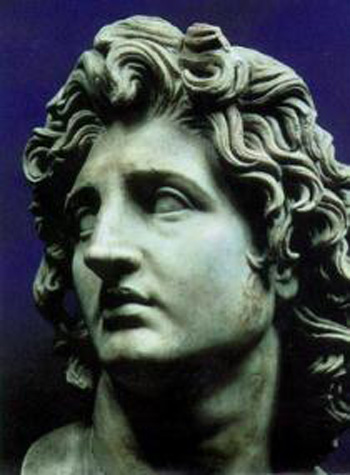 Regardless of his ideals, motives, or views about himself, one fact stands out: Alexander truly created a new age, the Hellenistic era. The word Hellenistic is derived from a Greek word meaning "to imitate Greeks." It is an appropriate way, then, to describe an age that saw the extension of the Greek language and ideas to the non-Greek world of the Near East. Alexander's destruction of the Persian monarchy had extended Greco-Macedonian rule over an enormous area. It created opportunities for Greek engineers, intellectuals, merchants, soldiers, and administrators. While the Greeks on the mainland might remain committed to the ideals of their city-states, those who followed Alexander and his successors participated in a new political unity based on the principle of monarchy. Alexander had transformed his army from a Macedonian force into an international one, owing loyalty only to himself. His successors used force to establish military monarchies that dominated the Hellenistic world after his death. Autocratic power, based on military strength and pretensions of divine rule, became a regular feature of those Hellenistic monarchies and was part of Alexander's political legacy to the Hellenistic world. His vision of empire no doubt inspired the Romans, who were, of course, the real heirs of Alexander's legacy. 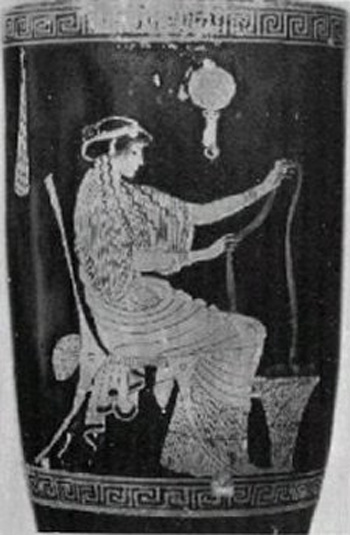
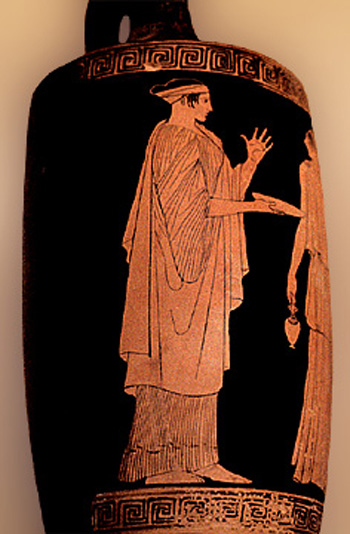 The celebrations or 'gamos' was held to honor the passing of a girl from her father to her husband. These celebrations could vary in length and religious influence. The bride would be washed and dressed by female relatives. A white dress would be worn, as it was the correct color for religious ceremonies. The girl would also wear a crown, and carried a pomegranate or a fruit with many seeds- which could possibly symbolize fertility. Sacrifice was an important part of the wedding- the father of the bride also offered sacrifices at the family altar, rigorously announcing that he was giving his daughter away. The childhood toys of the girl would be offered to Artemis. A source of this time confirms this ritual- 'Timareta, being about to be married, has consecrated to thee, O Artemis of the Marshes, her tambourines, and the ball she was so fond of, and her hairnet, her dolls, too, she has dedicated in a befitting manner, with her clothes-a virgin's offering to thee, O Goddess. On the second day of celebrations a feast was held for all the families. The new bride and groom would be escorted to the groom's home, where he would pretend to abduct her, and then carry her across the threshold. The couple and their family would then kneel before the hearth where the bride would be formally introduced to the divinity of her new house. The young bride would only become a full member of the new household when she produced her first child. Women had very little influence, or power in Greek society and were not highly regarded until they could produce this child. A newly married wife would be eager to fulfill her duty as a wife and bear a child. Childbirth in Athens always took place in the home. Before the birth, the house would be smeared with pitch (a black substance), as a protection against evil spirits. Normally, the women of the house would deliver the baby. Occasionally in wealthy families they would have a midwife deliver the child. Because contraception was limited Athenian woman had numerous pregnancies. There was contraception in ancient Greece, but it was not readily used or available. Most often it was used after a woman had had a few children. Not all babies survived and life expectancy for women was 35-40 years old, presumably because they were worn out from childbearing. In ancient Greece, mortality rights for mothers and babies were high. To notify the neighbors of a birth of a child, a woolen strip was hung over the front door- this indicated a female baby. An olive branch indicated a boy had been born. Families did not always keep their new child. After a woman had a baby, she would show it to her husband. If the husband accepted it, it would live, but if he refused it, it would die. Babies would often be rejected if they were illegitimate, unhealthy or deformed, the wrong sex (female for example), or too great a burden on the family. These babies would not be directly killed, but put in a clay pot or jar and deserted outside the front door or on the roadway. In ancient Greek religion, this practice took the responsibility away from the parents because the child would die of natural causes, for example hunger, asphyxiation or exposure to the elements. If the baby were accepted, there would be a celebration- given a name, and presented to the gods and goddesses. It was difficult for a woman to divorce her husband. Most divorces in ancient Greece were by the husband. If he chose to divorce her he would reject her in front of witnesses or merely send her back to her family home. Upon the divorce, the dowry would be returned and the children (if any) would remain with the father. Women would lose all rights to their children. If however, the woman had committed adultery the husband did not have to return the dowry. For a woman to divorce her husband she would have to endeavor to find an archon (and Athenian official) and provide good reasons for a divorce to be granted. A man, however, could put a stop to all this by simply confining the woman to the home. Athenian fathers had all rights to end the marriage, until the woman produced a child. Before that, he could brake up the marriage so that the woman could return home, or marry another man. Once a woman was married her husband controlled all property. Any property that she might have inherited would go directly to her husband. She had no rights to wander about the town, without a just cause. Any respectable woman would not be seen in public. Greek women had virtually no political rights of any kind and were controlled by men at all stages of their lives. Since men spent most of their time away from their houses, women dominated Greek home life. The wife was in charge of raising the children and making the families clothes. She supervised the daily running of the household. In a totally slave based economy plentiful numbers of female slaves were available to cook, clean and carry water from the fountain. Only in the poorest homes was the wife expected to do these duties by herself. Custom dictated that women should limit her time outside the home. Visiting with a female neighbor was really the only appropriate time for the woman to leave her indoor duties. Even though the women of ancient Greece were not important, the goddesses were especially Athena- goddess of wisdom, war, arts and crafts and the city of Athens. The people of Athens built a large temple for her and it's called the Parthenon. The people of Athens put a picture of her on their coins and as Athens became more imperialistic, Athena started to look different, more war like. Athenian women could not own property in their own right. If they were married, complete control went to their husband. If they divorced, control and rights over any property went back to their father or nearest male relative. Women had very few rights, let alone legal rights. They had no rights to vote or take part in the operation of the state. They were not allowed to watch the Olympic Games, as the participants did not wear clothes. Chariot racing was the only game women could win, and only then if they owned the horse. Most Greek households had slaves. Female slaves cooked, cleaned, and worked in the fields. If a woman did not have a slave, then they had a lot more freedom, but a lot more work to do. Jobs that a woman could perform in the public sphere included weddings, funerals and state religious festivals in which women were expected to play prominent public roles. The Thesmophoria was a significant religious event that women were expected to attend. Men were strictly prohibited and was reserved for married women only. The women were expected to prepare sacrifices and offerings for the goddesses. Another female's festival was that of Haloa, celebrated to protect the sowing of the grain. Sacrifices were expected to be made by the women to the goddess Demeter, her daughter Kore and also to the god of sea Poseidon. ALL women were expected to celebrate and perform at this festival. Written and archaeological evidence suggests that women played a significant role in the religious life in Ancient Greece. As part of a woman's public duties, she would be expected to play an important role at funerals. There is evidence for this in both written and archaeological forms. Plutarch in his 'Life of Solon', records laws decided in c. 590 BC, regarding the limitation of expenses and ostentatious behavior at funerals in Athens. Athenian women were not allowed to cry neither sacrifice an ox, nor bury more than three garments with the body. Excavations of the Athenian Kerameikos- an ancient burial ground outside the city walls, has also revealed a lot of valuable information. Women played an important role in preparing the dead body for burial. In a funeral procession, the females were expected to carry the libations at the front of the group, FOLLOWED by the male relatives. This was probably the only time a woman was ever allowed to be ahead of the males! According to Solon's laws, the amount of female relatives was limited. On the third and ninth days of the funeral women were expected to deliver food and libations to the gravesite. An extract from Plutarch's 'Life of Solon' states: (Solon) also made a law which regulated women's appearances in public, as well as their mourning and their festivals, and put an end to wild and disorderly behavior......besides this he abolished the practice of lacerating the flesh at funerals, of reciting set dirges, and of lamenting any person at the funeral ceremonies of another. People were also forbidden to sacrifice an ox at the graveside, or to bury their dead with more than three changes of clothing or to visit the tombs of others besides their own family except at the time of burial.... Offenders shall be punished by the board of censors for women weak and unmanly behavior, and for carrying their mourning to extravagant lengths'. It appears that people had altered views of women. Some saw them as important mothers of citizens and for the passing on of legitimacy, women were protected and sheltered, even in their own houses, from the peeping eyes of other men. They had limited access to society and the activities that took place there. Despite this, the writer Simonides depicted women as different types of animals- women represented the forces of chaos. Women were viewed as highly sexual beings who could not control their sexual urges and therefore had to be restricted for their own benefit. Compare this, however, to his paradox in which he explains to the ancient Greeks, 'woman is the consumer of men, their sex, their strength, their food, and their wealth, and the instigator of all evils in the world; yet without her, society cannot continue'. Euripides from his book ' Meda' writes; 'If only children could be got some other way without the female sex! If women didn't exist, human life would be rid of all its miseries'. These two authors depict the most constant view of women in ancient times. Most men felt that women were only necessary to produce children. Many scenes on Greek Pottery depicted women. Many of these women were either dancing girls or prostitutes. This shows that men had little respect for this class of women, as they are pictured as slaves to men's desires. Certain pots also paint the pictures of the ancient goddesses. A particular pot made in the early 5th Century BC shows the goddess Athena driving a four –horse chariot or quadriga. This explains to us, that the men were a lot more taken with the goddesses of their time, rather than their own women. Sculptures also were made of only the goddesses, and never of the ordinary women. Occasionally, Greek vases showed rituals of their culture. For example on an Attic Red Figure Hydria from 460-450 BC by the Penthesileia Painter, it shows a matron, joined by her young daughter and shorthaired servant, holding a three-legged basket. Behind is a stool with a woven cushion. The items most commonly illustrated on vases and on stone reliefs include chairs, stools, couches, tables and various kinds of chests, boxes and baskets. Stories, poems, and plays by the Greek author Homer tell us a great deal about how men viewed the gods and goddesses. They placed a lot of importance on their goddesses, and once again proves that they regarded the goddesses more high than that of their own women. Vase scenes portraying women inside their houses tend to be sparing in specific details. The common presence of columns suggests that women spent much of their time in the courtyard of the house, the one place they could regularly enjoy fresh air. Greek cooking equipment was small and light and could be easily set up there. In sunny weather, women probably sat in the roofed over areas of the courtyard, for the ideal female beauty was a pale complexion.  The work and freedom that a woman did eminently depended on their social position in society. There were three main classes of women in Ancient Greece. There was the wives class. The wives had to stay at home and weave things. They were considered respectable women. They were not allowed to go anywhere except for religious ceremonies. Then there were the Concubines. They were the poor women (widows, slaves and girls that were left out to die by their parents when they were babies) that were prostitutes. There was also the hetaerae class. The hetaerae class were a lot more educated than the wives class. They were companions to men, only if men paid an expensive price. They met the men at parties or festivals. As mentioned, the wives class did work at home, looking after the children, the house and attending to small duties. The prostitute's class of women were sexual companions to men. There were obviously double standards in Ancient Greece, because citizen wives and daughters were protected, but the prostitutes or pornoi were open to all forms of sexual exploitation. These women moved freely throughout society, with basically no rules surrounding them. Prostitutes were maintained by men, or worked in brothels and on the streets. A 4th Century fragment of writing describes how the common prostitute lived- 'too tall to wear thin slippers, too small a cork sewn onto her shoes, no hips? Put on a bustle and onlookers will comment on her nice bottom.... etc'. The hetairai or hetaerae were not only men's sexual companions but also their social and intellectual companions. Similar to the prostitutes, in that they were not protected or respected and were also open to all forms of sexual exploitation. The differences being that sometimes these women developed monogamous relationships with men, but their children were classified as illegitimate and had no rights. Unlike citizen wives, these women did not lead a sheltered, restricted life. Instead they too moved freely in society, shopping, attending theatre etc. They were often foreign and skilled at music, dancing, singing and intellectual conversation. They were also obviously trained and skilled in the art of pleasing men. From an ancient Greek comedy the following comments are made about this class of woman; ' Besides, isn't a " Companion " (hetaera) more well intentioned than a wedded wife? Yes, far more and most understandably. For a wife remains at home contemptuous because of law, but a companion knows that a man must be bought by her attentions or she will need to go and find another'. Ancient Athens had a large slave population. Women slaves were usually the result of the spoils of a foreign war, worked in private households as maids, nurses, cooks, or in industries such as cloth making. They had no rights and were at the mercy of their master or mistress. Slave prices varied. A document from 415 BC shows the price of female slaves ranging from 220 drachmas to 85 drachmas. The principal work of upper-class women was to take good care of their homes, children and slaves and to balance the housekeeping budget. Jobs included wool buying, then cleaning, carding, spinning, weaving and dyeing it; making garments for the entire household. Women of poorer classes, who could not afford slaves, had to work in the fields or on stalls in the market place alongside men. Evidence from written and archaeological sources suggests that the poorer women were involved in a range of occupations, such as ribbon selling and grape picking. In Aristophanes plays, he refers to women as innkeepers, wet-nurses, bakers, myrtle-wreath and vegetable sellers, perfume sellers, unguent boilers, launders, honey-sellers, wool workers and 'garlic-selling barmaid bakehouse girls'. Some foreign immigrants ran brothels, although a lot of brothels were state-owned. The far most respected job that a woman could do was run a household. The work that the poorer class of women did was not at all valued, so they only way to gain any respect in ancient Greek society was to be a housewife.  The particular geography of the Italian peninsula had a decisive influence upon the course of Rome's development. Aside from excellent marble and small quantities of lead, tin, copper, iron, and sliver, Italy has no mineral resources to speak of. Despite its extensive coastline, Italy has only a few good harbors, and most of these face toward the west, away from Greece and the Near East. Ancient Italy did have sizeable forests and a considerably greater amount of fertile land than did Greece. But Italy was also more exposed to invasion. The Alps posed no effective barrier to the influx of peoples from central Europe, and the low lying Italian coastline invited conquest by sea. The Romans were absorbed in military pursuits almost from the moment of their settlement on Italian soil because they were continuously forced to defend their own conquests against other invaders. By the beginning of the sixth century, under Etruscan influence, Rome began to change from a pastoral community to an actual city. The Etruscans were responsible for an outstanding building program. They constructed the first roadbed of the chief street through Rome, the sacred way, before 575 B.C. and oversaw the development of temples, markets, shops, streets, and houses. By 509 B.C., the date when the monarchy was supposedly overthrown and a republic form of government was established, a new Rome had emerged, essentially as a result of the fusion of Etruscan and native Roman elements. The transition from a monarchy to a republican government was not easy. Rome felt threatened by enemies from every direction and, in the process of meeting these threats, embarked on a course of military expansion that led to the conquest of the entire Italian peninsula. During this period of expansion in Italy, the Roman Republic developed political institutions that were, in many ways, determined by the social divisions that existed within the community. Rome was deeply influenced by Greek culture, but Rome was also a distinctive civilization in its own right. On the other hand, the Romans were much more tradition minded than were the Greeks. Rome revered its old agricultural traditions, its household gods, and its sternly military values. But as their empire grew, the Romans also came to see themselves as having a divinely ordained mission to civilize their world by teaching it the arts of law and government that were Rome's own peculiar genius. Link: Wealth of Info on Ancient Rome  "The duty of a general is to ride by the ranks on horseback, show himself to those in danger, praise the brave, threaten the cowardly, encourage the lazy, fill up gaps, transpose a unit if necessary, bring aid to the wearied, anticipate the crisis, the hour and the outcome." Onasander's summary of a General's battlefield role was written in the middle of the 1st century A.D., but reflected a command style which persisted for at last seven hundred years and was characteristically Roman. Rome naturally had an army from its earliest days as a village on the Tiber bank. At first it consisted of the king, his bodyguard and retainers, and members of clan-groups living in the city and its meager territory. the army included both infantry and cavalry. Archaeological finds from Rome would suggest circular or oval shields, leather corsets with metal pectorals protecting the heart and chest, and conical bronze helmets. The wars between Rome and her neighbors were little more than scuffles between armed raiding bands of a few hundred men at most. Link: Early Roman Empire The creation of a formal state organization that accompanied the full urbanization of Rome in the last quarter of the 7th century B.C. paralleled and was integral to the spread of new arms, armor, and military tactics in central italy at the same time. A similar pattern had occurred at the beginning of the 7th century B.C. in Greece. the old, warriors backed up by a rather disorganized mass of retainers as seen in Homer, gave way to tactics based on the hoplite phalanx, The first formal Roman field army was a legion drawn from the three tribes, with each tribe's ten "curiae" providing a quota of 10 to 40 cavalry and 100 heavy infantry for the hoplite phalanx. The 1000 total heavy infantry of each tribe was commanded by a tribune of the soldiers. At the top, the supreme command belonged to the king or his appointee, master of the army. 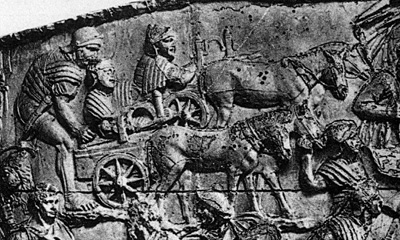 By 264 B.C. the internal social and political struggles of the early Republic had largely abated. To preserve unity in the face of hostile neighbors, patrician leaders had gradually agreed to grant plebeians equal access to the social and political levels of power. The acquisition of booty and territory from conquered neighbors has helped the economic distress of the plebeians. Between 264 and 133 B.C. Yearly warfare had practically become a way of life during the early Republic. Citizens of all classes had become accustomed to the profits of war, and aristocratic leaders craved military glory and benefited politically from the popularity won in victorious campaigns. In the process, the Republic had matured militarily and diplomatically into one of the major powers of the Mediterranean world. The year 264 B.C., punctuates the completion of Rome's control of peninsular Italy with the destruction of the rebellious Etruscan city of Volsinii. At the same time, it opens up a new chapter in the expansion of Rome's power with the start of the First Punic War. By this time, carthage had become a major power; she had been extensively influenced by the Greeks through constant commercial contact and rivalry in the western Mediterranean. In a strategically advantageous position at the narrowest part of the Mediterranean and with access to either end, Carthage was in an ideal location for a maritime power. Carthage controlled by far the richest mining resources of the western Mediterranean basin. By the third century, Carthage's workshops were turning out jewelry, ivory work, pottery, metal goods, and highly prized purple-dyed cloth in great quantities. An even greater source of wealth was the export of Carthaginian agricultural products: wine, olive oil, and various fruits like pomegranates and figs. Carthage manned her large navy with loyal citizens commanded by naval experts. The army, on the other hand, contained few citizen troops and was composed largely of conscripted natives of Libya, Sardinia, and Spain; troops hired from the allied but independent chiefs of what are now Algeria and Morocco; and mercenaries picked up in every part of the Mediterranean. It was difficult to maintain the army's loyalty when Carthaginian prestige or funds were low. A number of underlying factors helped to cause the First Punic War. First, by 264 B.C., Rome had extended her system of alliances to include all of the Greek city-states in southern Italy. Many were heavily involved in commerce and competed with Carthage. If Carthage could have gained control of Sicily and the vital Straits of Messana, she would have had a stranglehold on the shipping of the southern Italian Greek merchants. Many Romans believed that Rome, as the ally and patron of the southern Italian Greek cities, was bound to protect their commercial interests and prevent Messana from falling into Carthaginian hands. Another important factor leading to war was the traditional Roman fear of powerful neighbors - fear that had become almost paranoid after centuries of struggle with neighboring peoples like the Etruscans and Samnites. A third factor prompting some Romans to provoke a war with Carthage was the desire for military glory among ambitious aristocrats. 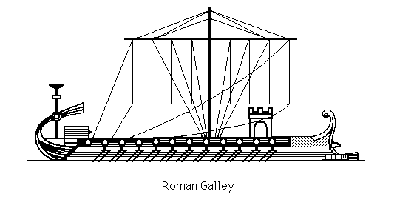 The Roman Navy was always considered an inferior arm and strictly under Army control. During the Punic Wars unexpected success had been obtained by a logical Roman idea that a warship was little ,ore than a floating platform on which the soldiers could be brought into contact with enemy ships. Rome almost lost all she had gained at sea by lack of seamanship and ignorance of navigation. It was possibly these factors which prevented the development of a navy and made her rely entirely on the Greek cities to provide ships when they were required. But as Rome gained control of the lands of the eastern Mediterranean, so the sea power of the Greek cities declined. Link: Ancient Roman Navy 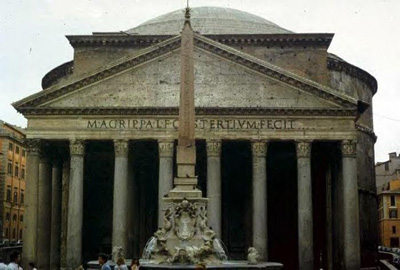 Every aspect of Roman society was permeated with religion. The official state religion focused on the worship of a pantheon of gods and goddesses, including Jupiter, Juno, Minerva, and Mars. As Rome developed and came into contact with other peoples and gods, the community simply adopted new deities. Hence the Greek Hermes became the Roman Mercury. By the end of the third century B.C., a rather complete amalgamation of Greek and Roman religion had occurred. Roman religion focused on the worship of the gods for a very practical reason - human beings were thought to be totally dependent on them. Not morality but the exact performance of ritual was crucial to establishing a right relationship with the gods. What was true for individuals was also valid for the state: it also had to observe correct ritual in order to receive its reward. Accurate performance of ritual was performed by a college of priests or pontiffs, who thus bore responsibility for maintaining the right relationship between the state and the gods. If the rituals were performed correctly, then the Romans would obtain the "peace of the gods." No doubt the Roman success in creating an empire was a visible confirmation of divine favor. As Cicero, the first-century B.C. politician and writer, claimed, "We have overcome all the nations of the world, because we have realized that the world is directed and governed by the gods." Just as the state had an official cult, so did families. Because the family was regarded as a small state within the state, it had its own household cults, which included Janus, the spirit of the doorway, and Vesta, goddess of the hearth. Here, too, proper ritual was important, and it was the responsibility of the pater-familias as head of the family to ensure that religious obligations were properly fulfilled. Link: Roman Religion 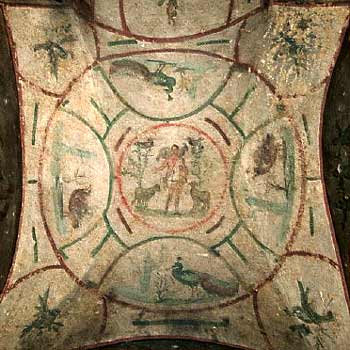 The sporadic persecution of Christians by the Romans in the first and second centuries had done nothing to stop the growth of Christianity. It had, in fact, served to strengthen Christianity as an institution in the second and third centuries by causing it to shed the loose structure of the first and move toward a more centralized organization of its various church communities. Crucial to this change was the emerging role of the bishops, who began to assume more control over church communities. The Christian church was creating a well-defined hierarchical structure in which the bishops and clergy were salaried officers separate from the laity or regular church members. Why was Christianity able to attract so many followers? First of all, the Christian message had much to offer the Roman world. The promise of salvation, made possible by Christ death and resurrection, had immense appeal in a world full of suffering and injustice. Christianity seemed to give life a meaning and purpose beyond the simple material things of everyday reality. Christianity gave life a new meaning to life and offered what the Roman state religions could not, a personal relationship with God and a link to higher worlds. Christianity proved attractive to all classes. The promise of eternal life was for all, the rich, poor, aristocrats, slaves, men, and women. Although it did not call for revolution or social upheaval, Christianity emphasized a sense of spiritual equality for all people.
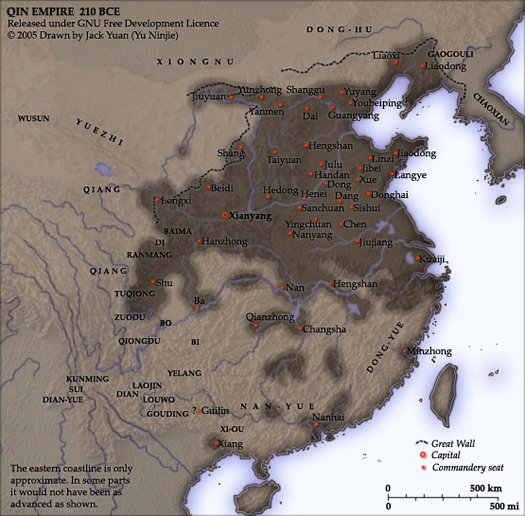 The early development of China's civilization occurred with little contact with the other early civilizations of Eurasia. The reasons for China's relative isolation were geographic: communication with west and south Asia was very difficult, impeded by high mountains and vast deserts. Thus, in comparison to India and the ancient Middle East, there was less cross-fertilization through trade and other contact with other comparably advanced civilizations. Moreover, there were no cultural breaks comparable to the rise of the Aryans in India or the Assyrians in Mesopotamia; there were no new peoples and no new languages. 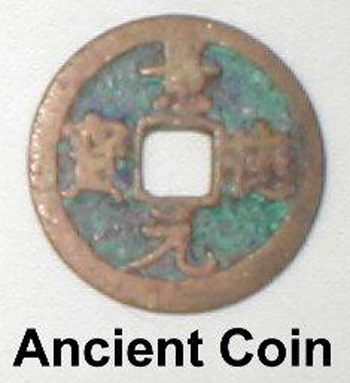 The impact of early China's relative isolation is found in many distinctive or unique features of its culture. Perhaps the most important of these is its writing system. Unlike the other major societies of Eurasia, China retained a logo graphic writing system, with a separate symbol for each word. This writing system shaped not only Chinese literature and thought but also key social and political processes, such as the nature of the ruling class and the way Chinese interacted with non-Chinese. Chinese history is discussed in terms of a succession of dynasties. The Shang Dynasty (ca 1500 - ca 1050 B.C.) was the first to have writing, metalworking, cities, and chariots. The Shang kings played priestly roles, serving as intermediaries with both their royal ancestors and the high god Di. The Shang were overthrown by one of their vassal states, the Zhou (ca 1050 - 256 B.C.). The Zhou rulers set up a decentralized, feudal governmental structure. After several centuries, this structure evolved into a multistate system. As warfare between the states intensified from the sixth century B.C. on, social and cultural change also quickened. Aristocratic privileges declined, and China entered one of its most creative periods, when the philosophies of Confucianism, Daoism, and Legalism were developed. 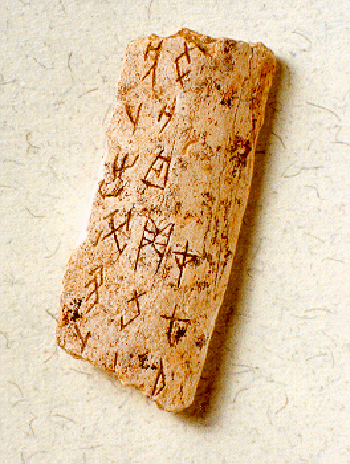 Human communities have existed in China for several hundred thousand years. Sometime around the eighth millennium B.C., the early peoples living along the riverbanks of northern China began to master the cultivation of crops. A number of these early agricultural settlements were in the neighborhood of the Yellow River, where they gave birth to two Neolithic societies known to archaeologists as the Yangshao and the Longshan cultures (sometimes identified in terms of their pottery as the painted and black potter cultures, respectively). Similar communities have been found in the Yangtze valley in central China and along the coast to the south. The southern settlements were based on the cultivation of rice rather than dry crops such as millet, barley, and wheat, but they were as old as those in the north. Thus agriculture, and perhaps other elements of early civilization, may have developed spontaneously in several areas of China rather than radiating outward from one central region. 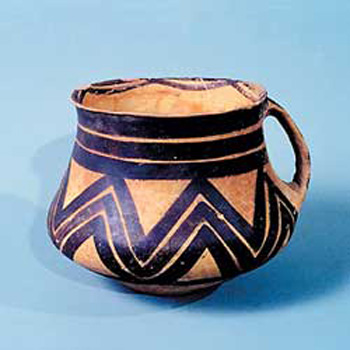 At first, these simple Neolithic communities were hardly more than villages, but as the inhabitants mastered the rudiments of agriculture, they gradually gave rise to more sophisticated and complex societies. In a pattern that we have already seen elsewhere, civilization gradually spread from these nuclear settlements in the valleys of the Yellow and Yangtze Rivers to other lowland areas of eastern and central China. The two great river valleys, then, can be considered the core regions in the development of Chinese civilization. Although these densely cultivated valleys eventually became two of the great food-producing areas of the ancient world, China is more than a land of fertile fields. In fact, only 12 percent of the total land area is arable, compared with 23 percent in the United States. Much of the remainder consists of mountains and deserts that ring the country on its northern and western frontier. This often arid and forbidding landscape is a dominant feature of Chinese life and has played a significant role in Chinese history. The geographical barriers served to isolate the Chinese people from advanced agrarian societies in other parts of Asia. Link: Chinese Writing 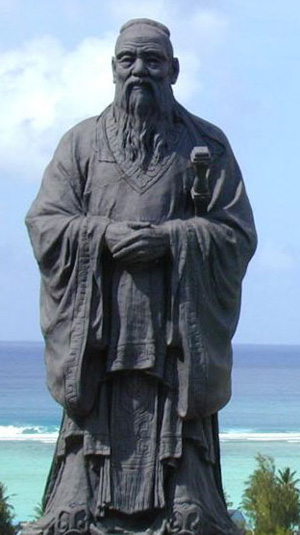 The constant warfare of early China helped rather than hindered intellectual creativity. People wanted solutions to the disorder they saw around them. Rulers and high officials took advantage of the destruction of states to recruit newly unemployed men to serve as their advisers and court assistants. Lively debate often resulted as these strategists proposed court policies and defended their ideas against challengers. Followers took to recording their teachers' ideas, and the circulation of these "books" (rolls of silk, or strips of wood or bamboo tied together) served further to stimulate debate. Confucius (traditional dates, 551-479 B.C.) was the first and most important of the men of ideas seeking to influence the rulers of the day. As a young man, Confucius served in the court of his home state of Lu without gaining much influence. After leaving Lu, he set out with a small band of students and wandered through neighboring states in search of a new ruler who would take his advice. Confucius's ideas are known to us primarily through the sayings recorded by his disciples in the Analects. The thrust of his thought was ethical rather than theoretical or metaphysical. He talked repeatedly of an ideal age in the early Zhou Dynasty, which he conceived of as a perfect society in which everyone was devoted to fulfilling his or her role: superiors looked after those dependent on them; inferiors devoted themselves to the service of their superiors; parents and children, husbands and wives, all wholeheartedly embraced what was expected of them. 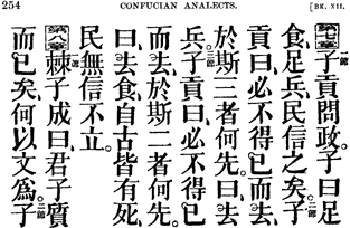 Confucius considered the family the basic unit of society. He extolled filial piety, which to him meant more than just reverent obedience of children toward their parents: The Master said, "You can be of service to your father and mother by remonstrating with them tactfully. If you perceive that they do not wish to follow your advice, then continue to be reverent toward them without offending or disobeying them; work hard and do not murmur against them." The relationship between father and son was one of the five cardinal relationships stressed by Confucius. The others were between ruler and subject, husband and wife, elder and younger brother, and friend and friend. Mutual obligations of a hierarchical sort underlay the first four of these relationships - the senior leads and protects; the junior supports and obeys. The exception was the relationship between friends, which was conceived in terms of mutual obligations between equals. A man of moderation, Confucius was an earnest advocate of gentlemanly conduct. He redefined the term gentleman (junzi) to mean a man of moral cultivation rather than a man of noble birth. He repeatedly urged his followers to aspire to be gentlemen of integrity and duty, rather than petty men intent on personal gain. The gentleman, he said, "feels bad when his capabilities fall short of the task. He does not feel bad when people fail to recognize him." Confucius did not advocate social equality, but his teachings minimized the importance of class distinctions and opened the way for intelligent and talented people to rise in the social scale. Link: Brief "Analects"
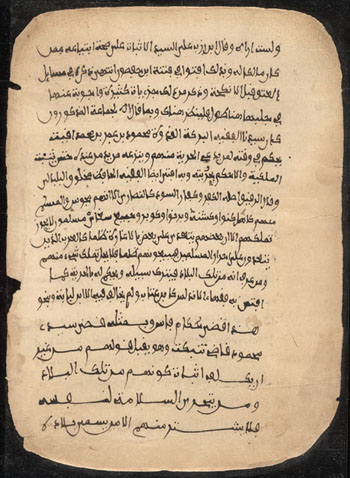 The Arabic language, a Semitic tongue of the Afro-Asiatic family, defined and linked the Arab peoples, however divided they were by religion, blood feuds, rivalry, and conflict. From the Yemen north to Syria-Palestine and the Euphrates, the major element of culture that the Arabs shared was their highly developed poetic idiom. Traditionally, every tribe had a poet to exhort its warriors and insult its enemies before battle. Poetry contests were also held, often in conjunction with the annual trade fairs that brought diverse tribes together under a general truce. The popular notion of Islam as a "religion of the desert" is largely untrue. Islam began in a commercial center and first flourished in an agricultural oasis. Its first converts were settled Meccan townsfolk and date farmers of Yathrib (Medina). Before becoming Muslims, most of these Arabs were pagans, but some were Jews or Christians, or influenced by Jews or Christians. Caravans passed north and south through Mecca, and no merchant involved in this traffic, as Muhammad himself was, could have been ignorant of diverse cultures. Early Muslim leaders used the Arabs as warriors and looked to Arab culture for roots long after the locus of Islamic power had left Arabia. But the empire and civilization they built were centered in the heartland of Eurasian urban culture and based on settled communal existence rather than desert tribal anarchy. Link: Expeditions to the Americas before Columbus Link: The Kon Tiki Expedition Muhammad (ca. 570-632) was raised an orphan in one of the less well-to-do commercial families of the old Meccan tribe of Quraysh. Later, in the midst of a successful business career made possible by his marriage to Khadija, a wealthy Meccan widow and entrepreneur, he grew troubled by the idolatry, worldliness, and lack of social conscience around him. These traits would have equally offended sensitive Jewish or Christian morality, about which he certainly knew something. Muhammad did not find his answers in these traditions; they remained somehow foreign to mainstream Arab culture, even though some Arab tribes were Jewish or Christian. Muhammad's discontent with the moral status quo and older religious solutions paved the way for a sudden religious experience that changed his life when he was about forty years old. He felt himself called by the one true God to "rise and warn" his fellow Arabs about their frivolous disregard for morality and the worship due their creator. On repeated occasions revelation came to him through a figure who was gradually identified as God's messenger angel, Gabriel. It took the form of a 'reciting' (Koran) of God's word - now rendered in "clear Arabic" for the Arabs, just as it had been given to previous prophets in Hebrew or other languages for their peoples. The message of the Koran was clear: The Prophet is to warn his people against worship of false gods and all immorality, especially injustice to the unfortunate or weak - the poor, orphans, widows, and women in general. At the end of time, on judgment day, all will be bodily resurrected to face eternal punishment in hellfire or eternal joy in paradise, according to how each has lived. The proper response is "submission" (Islam) to God's will, becoming Muslim ("submissive" or "surrendering") in one's worship and morality. All of creation praises and serves God by nature except humans, who have the choice either to obey or to reject Him. The Koran revelations explicitly state that Muhammad is only the last in a long line of prophets chosen to bring God's word: Noah, Abraham, Moses, Jesus. Because the communities of these earlier prophets had strayed from their scriptures' teachings or altered them, Muhammad was given one final iteration of God's message. Jews and Christians, like pagans, were summoned to respond to the moral imperatives of the Koran. 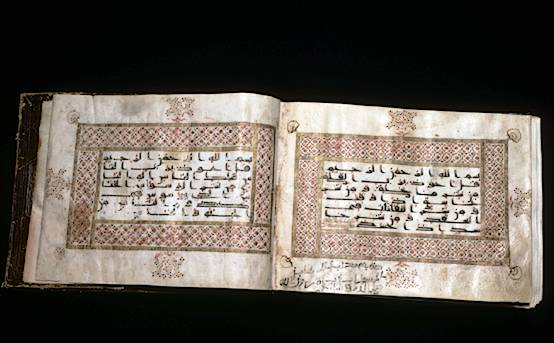 Muhammad quickly cemented ties between the Meccan emigrants and the Medinans, many of whom became converts. Raids on his Meccan enemies' caravans established his leadership. They reflect the economic dimension of the Medinan-Mecccan struggle. The Arab Jews of Medina largely rejected his religious message and authority. They even made contact with his Meccan enemies, moving Muhammad to turn on them, kill or enslave some, banish others, and take their lands. The basic Muslim norms took shape in Medina: allegiance to the Umma; honesty in public and personal affairs; modesty in personal habits; abstention from alcohol and pork; fair division of inheritances; improved treatment of women, especially as to property and other rights in marriage; careful regulation of marriage and divorce; and, eventually pilgrimage to Mecca at least once in a lifetime, if one is able. Although they were quick to adopt and adapt existing traditions in the lands they conquered, the Muslims brought with them a new world view that demanded a new political, social, and cultural reality, however long it might take to effect it. Beyond military and administrative problems loomed the ultimately more important question of the nature of Islamic society. Under the Prophet the new community of the Umma had replaced, at least in theory and basic organization, the tribal, blood-based sociopolitical order in Arabia. Yet once the Arabs (most of whom became Muslims) had to rule non-Arabs and non-Muslims, new problems tested the ideal of an Islamic polity. Chief among these were leadership and membership qualifications, social order, and religious and cultural identity. Islamic conquests resulted in the chronic warfare with one another over many decades. The new Islamic vision of society and life to unite the Arabs and to attract others as well. Its corollary was the commitment among the Islamic leadership to extend "the abode of submission" abroad. However, too much has been made of Muslim zeal for martyrdom. Assurance of paradise for those engaged in jihad, or "struggle" in the path of God," is less likely to have motivated the average Arab tribesman who at least at the beginning, was usually only nominally a Muslim, as much as promise of the booty of war. The marginal life in the peninsula was such that the hope of greater prosperity must have been compelling.  A new drama began to unfold in the sixth century with the rise of a rival far more dangerous to the west than the German tribes; the new faith of Islam. During the lifetime of the prophet Muhammad (570 - 632) and thereafter, invading Arab armies claimed the attention and resources of the emperors in Constantinople, who found themselves in a life-and-death struggle. Unlike the Germanic invaders, who absorbed and adopted the culture and religion of Rome, the Arabs, although generally tolerant of Christian and Jewish minorities, ultimately imposed their own culture and religion on the lands they conquered. By the middle of the eighth century Arabs had conquered the southern and eastern Mediterranean coastline (territories currently held, for the most part, by Islamic states) and occupied parts of Spain, which they controlled or strongly influenced until the fifteenth century. In addition, their armies pushed north and east through Mesopotamia and Persia and beyond. The inhabitants of much of this territory, although Christian, were, like the Arabs, Semitic. Any religious unity they felt with the Byzantine Greeks may have been offset by hatred of the Byzantine Greek army of occupation. The Christian community was in any case badly divided. The Byzantine emperor Heraclius had tried to impose Greek "orthodox" beliefs on the churches of Egypt and Syria, creating enmity between Greek and Semitic Christians. As a result, many Egyptian and Syrian Christians, hoping for deliverance from Byzantine oppression, may have welcomed the Islamic conquerors. 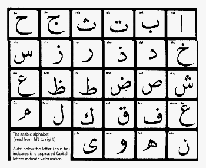 The Muslim conquerors tolerated Christians and Jews, provided they paid taxes, kept their distance, and made no efforts to proselytize. Muslim communities. Always anxious to maintain the purity of their religion and culture, the Arabs forbade mixed marriages and any conscious cultural interchange. Special taxes on conquered peoples encouraged them to convert to Islam. Assaulted from east and west and everywhere challenged in the Mediterranean, Christian Europe developed a lasting fear and suspicion of the Muslims. The Byzantine Emperor Leo III (r. 717-740) stopped Arab armies at Constantinople after a year's siege (717-718); during the next several centuries Byzantine rulers maintained a successful defense against the Arabs, for a time expanding militarily and commercially into Muslim lands. In the west, the Franks under Charles Martel defeated a raiding party of Arabs on the western frontier of the Frankish kingdom near Tours (today in central France) in 732, ending the possibility of Arab expansion into the rest of Europe by way of Spain. From the end of the seventh century to the middle of the eleventh, the Mediterranean remained something of a Muslim lake, and while western trade with East Asia was not cut off during these centuries, it was significantly diminished and carried on in keen awareness of Muslim dominance. Among the Byzantines education was highly prized, and because of them many masterpieces of ancient Greek literature survived to fertilize the intellectual life of the modern world. The literature of the Byzantine Empire was predominantly Greek, although Latin was long spoken among top politicians, scholars, and lawyers. Indeed, Justinians's Code was first written in Latin. In mathematics and geometry the Byzantines discovered nothing new. Yet they were exceptionally important as catalysts, for they passed Greco-Roman learning on to the Arabs, who assimilated it and made remarkable advances upon it. The Byzantines were equally uncreative in astronomy and natural science, but they at least faithfully learned what the ancients had to teach. 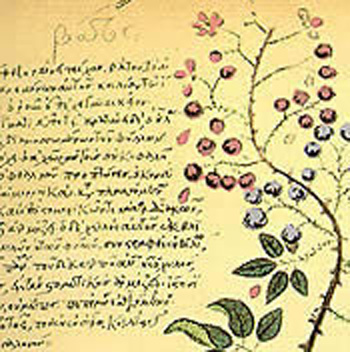 Only when science could be put to military use did the Byzantines make advances. The best-known Byzantine scientific discovery was chemical - "Greek fire," a combustible liquid that was the medieval equivalent of the flame thrower. In mechanics the Byzantines continued the work of Hellenistic and Roman inventors of artillery and siege machinery. The Byzantines devoted a great deal of attention to medicine, and the general level of medical competence was far higher in the Byzantine Empire than it was in the medieval West. The Byzantines assimilated the discoveries of Hellenic and Hellenistic medicine but added very few of their own. The basis of their medical theory was Hippocrates' concept of the four humors of the body. Byzantine physicians emphasized the importance of diet and rest, and relied heavily on drugs made from herbs. Perhaps their chief weakness was their excessive use of bleeding and burning, which often succeeded only in further weakening an already feeble patient. Hospitals were a prominent feature of Byzantine life, and the army too had a medical corps. In terms of territory, political power, and culture, the first period of Byzantine history (324 - 632) was by far its greatest. At the height of this period, Emperor Justinian (r. 527-565) ruled with the assistance of his brilliant wife, Empress Theodora. The daughter of a circus bear trainer - and, if the controversial Secret History of Justinian's court historian, Procopius, is to be believed, perhaps at one time a prostitute - Theodora rose from lowly origins to become an influential counselor and a major figure in imperial government. When in 532 Justinian contemplated abdication following riots that left much of Constantinople in ruins and thousands dead, Theodora stiffened his resolve and saved his rule. The imperial goal in the East - as reflected in the policy "one God, one empire, one religion" - was to centralize government and impose legal and doctrinal conformity throughout the empire. To this end Justinian collated and revised Roman law. Justinian's Corpus Juris Civilis (body of civil law) was a fourfold compilation undertaken by a learned committee of lawyers. These works had little immediate effect on medieval common law, but beginning with the Renaissance, they provided the foundation for most subsequent European law down to the nineteenth century, and they were especially helpful to rulers who aspired to centralize their states.  Religion also served imperial centralization. Since the fifth century the patriarch of Constantinople had crowned emperors in Constantinople. This practice reflected the close ties between rulers and the church. In 380 Christianity became the official religion of the eastern empire. The patriarchs of Constantinople, Alexandria, Antioch, and Jerusalem became very rich and powerful between the fourth and sixth centuries. As clerical ranks grew, the church in turn served the state as a welfare agency for the poor and needy. The empire was also home, although at times a less than hospitable one, to large numbers of Jews. Under Roman law Jews had legal protection so long as they did not proselytize among Christians, build new synagogues, or try to enter sensitive public offices or professions. Justinian (the emperor most intent on religious conformity within the empire) adopted a policy of encouraging Jews to convert voluntarily. Later emperors ordered all Jews to be baptized and granted tax relief to those who voluntarily complied. but neither persuasion nor coercion succeeded in converting the empire's Jews.
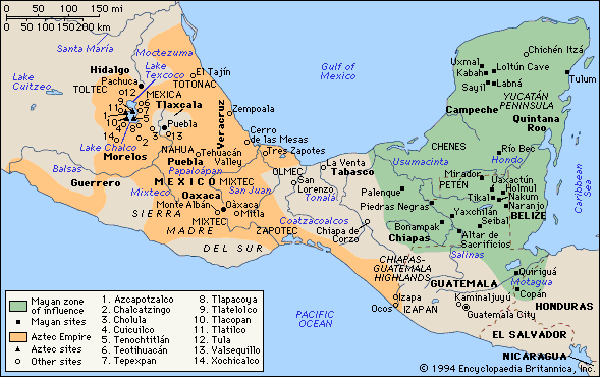 Our use of the word "Indian" for the indigenous peoples of the Americas stems from early European explorers' geographical misconceptions of where they were - they believed they were near the East Indies. South America contained a great diversity of peoples, cultures, and linguistic groups. Modern scholars estimate that around 1500 there were 350 tribal groups, 15 distinct cultural centers, and 150 linguistic stocks. Historians and anthropologists have tended to focus attention on the Maya, Incas, and Aztecs, but the inhabitants of those three empires represent a minority of the total indigenous population; they lived in geographical regions that covered a small percentage of Mesoamerica and South America. Other native peoples included the Aymaras, Caribs, Chibchas, Chichimecas, Ge, Guaranis, Mapuches, Otonis, Pueblos, Quibayas, Tupis, and Zapotecs. In North America, aboriginal peoples represent comparable diversity. These peoples shared no unified sense of themselves as "Indians." None of their languages had the word Indian. Nor was there any tendency among these peoples to unite in a common resistance to the foreign invaders. Rather, when confronting Europeans, each group of polity sought the most advantageous situation for itself alone. Of course, the idea of "discovery" meant nothing to them. Because much more is known about the Aztecs, Maya, and Incas than about other native peoples, the focus of this Unit is on them. The central feature of early American societies, however, is their great indigenous and cultural diversity.  Who were the Incas? Inca was originally the name of the governing family of an Amerindian group that settled in the basin of Cuzco. From the family, the name was gradually extended to all peoples living in the Andes valleys. The Incas themselves used the word to identify their ruler or emperor. Here the term is used for both the ruler and the people. As with the Aztecs, so with the Incas: religious ideology was the force that transformed the culture. Religious concepts created pressure for imperialist expansion - with fatal consequences. The Incas believed their ruler descended from the sun-god and that the health and prosperity of the state depended on him. Dead rulers were thought to link the people to the sun-god. When the ruler died, his corpse was preserved as a mummy in elaborate clothing and housed in a sacred and magnificent chamber. The mummy was brought in procession to all important state ceremonies, his advice was sought in times of crisis, and hundreds of human beings were sacrificed to him. In ordinary times, the dead ruler was carried to visit his friends, and his heirs and relatives came to dine with him. Some scholars call this behavior the "cult of the royal mummies" because it was a kind of ancestor worship.  Inca calendar The mummies were also a powerful dynamic force in Inca society. According to the principle of the "split inheritance," when an Inca ruler died, the imperial office, insignia, and rights and duties of the monarchy passed to the new king. The dead ruler, however, retained full and complete ownership of all his estates and properties. His royal descendants as a group managed his lands and sources of income for him and used the revenues to care for his mummy and maintain his cult. Thus a new ruler came to the throne land - or property - poor. In order to live in the royal style, strengthen his administration , and reward his supporters, he had to win his own possessions by means of war and imperial expansion. The "ayllu", or clan, served as the fundamental social unit of Inca society. All members of the "ayllu" owed allegiance to the "curacas," or headman, who conducted relations with outsiders. The "ayllu" held specific lands, granted it by hamlet or provincial authorities on a long-term basis, and individual families tended to work the same plots for generations. Cooperation in the cultivation of the land and intermarriage among members of the ayllu wove people there into a tight web of connections. Link: Inca Road System 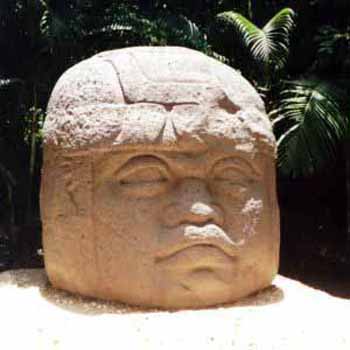 Olmec Sculpture The Maya trace their origins to the Olmec civilization along the Gulf of Mexico. This civilization had a arisen in the Yucatan peninsula. The area was a source for cacao trees and the inhabitants soon developed relations with other early civilizations in the region. Cacao trees were the source of chocolate, which was used as a beverage by the upper classes, while cocoa beans, the fruit of the cacao tree, were used as currency in markets throughout the region. Like some of the early religious beliefs in Asia and the Mediterranean, Mayan religion was polytheistic. Mayan gods shared many of the characteristics of deities of nearby cultures. The supreme god was named Itzamma (Lizard House). Deities were ranked in order of importance and had human characteristics, as in ancient Greece and India; some were evil rather good. 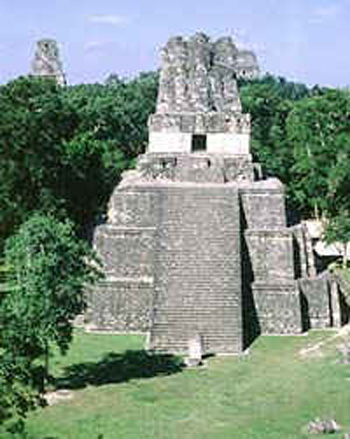 Maya Temple Physically, the Mayan cities were built around a ceremonial core dominated by a central pyramid surmounted by a shrine to the gods. Nearby were other temples, palaces, and a sacred ball court. The ball court was a rectangular space surrounded by vertical walls with a metal rings through which the players attempted to drive a hard rubber ball. The game had religious significance and the vanquished players were sacrificed in ceremonies held after the close of the game. Most of the players wee men, although there may have been some women's teams. 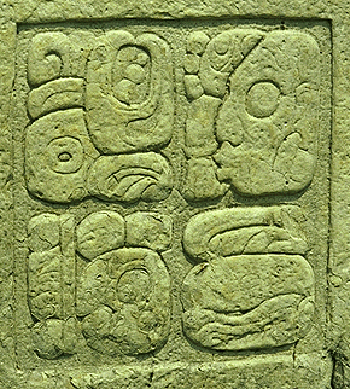 The Maya were the only Mesoamerica people to devise a complete written language. Like the Sumerian and Egyptian scripts, the Mayan system was composed of a mixture of ideographs and phonetic symbols, which were written in double columns to be read from left to right and top to bottom. The language was rudimentary in many ways. It had few adjectives or adverbs, and the numbering system used only three symbols, a shell for zero, a dot for one, and a bar for five. Unfortunately, when the Spanish conquered the Mayan civilization they made no attempt to decipher the language with the assistance of natives familiar with the script. Link: Mesoamerican History 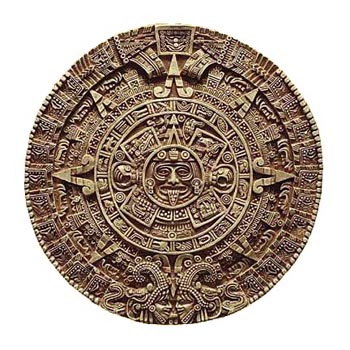 Aztec Calendar Although the terms Aztec and Mexica are used interchangeably here, Mexica is actually the more accurate word because it is a pre-Columbian term designating the dominant ethnic people of the island capital of Tenochtitlan-Tlalelolco. Aztec derives from Aztlan, the legendary homeland of the Mexica people before their migration into the Valley of Mexico, is not a pre-Columbian word, and was popularized by nineteenth-century historians. The Aztecs who appeared in the Valley of Mexico spoke the same Nahuatl language as the Toltecs but otherwise had nothing in common with them. Poor, unwelcome, looked on as foreign barbarians, the Aztecs had to settle on a few swampy islands in Lake Texcoco. From these unpromising beginnings, they rapidly assimilated the culture of the Toltecs and in 1428 embarked on a policy of territorial expansion. By the time Cortes arrived in 1519, the Aztec confederation encompassed all of central Mexico from the Gulf of Mexico to the Pacific as far south as Guatemala. Thirty-eight subordinate provinces paid tribute to the Aztec king. 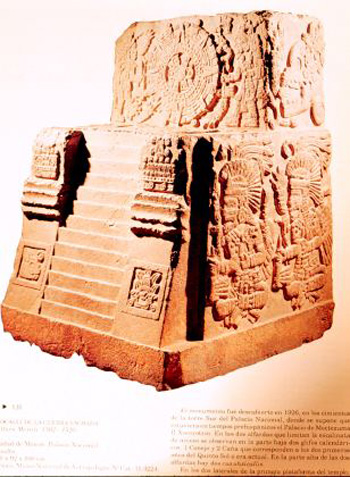 Aztec throne The growth of a strong mercantile class led to an influx of tropical wares and luxury goods: cotton, feathers, cocoa, skins, turquoise jewelry, and gold. The upper classes enjoyed an elegant and extravagant lifestyle; the court of Emperor Montezuma II (r. 1502-1520) was more magnificent than anything in western Europe. How, in less than two hundred years, had the Mexicans (from the Aztec word mizquitl, meaning "desolate land," or from Mixitli, the Aztec god of war) grown from an insignificant tribe of wandering nomads to a people of vast power and fabulous wealth?  Aztec temple The Aztecs' pictorial records attribute their success to the power of the war-god Huitzilopochtli and to their own drive and willpower. Will and determination they unquestionably had, but there is another explanation for their success: The Aztec state was geared for war. War was inextricably woven into the fabric of Mexica society. Rather than depending on professional soldiers or foreign mercenaries, as some European princes and city-states did, the Aztecs relied on their own citizens, and all levels of society were involved. Kings ordered war to acquire tribute for state use and captives for religious sacrifices. Nobles fought to win greater wealth. Commoners fought as a means of social advancement: the ordinary warrior who distinguished himself in battle could earn the status of meritocratic coble (cuahpipiltin), a Mexica rank comparable to that of European knight. This status brought the right to own land, to be supported by the king, to share in future war booty, and to hold civic and military office. Link: History of Chocolate Link: Mexica/Aztec Civilization
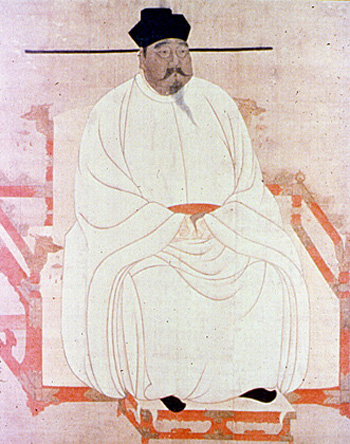 The founder of the Song Dynasty, Taizu (r.960-976), was a general whose troops elevated him to emperor when the previous ruler was succeeded by a young child. Taizu worked to make sure that such an act could not happen in the future by placing the armies under central government control. He retired or rotated his own generals and assigned civil officials to supervise them. In time civil bureaucrats came to dominate every aspect of Song government and society. The civil service examination system was greatly expanded to provide the dynasty with a constant flow of men trained in the Confucian classics.  Curbing the generals ended warlordism but did not solve the military problem of defending against the Khitans to the north. After several attempts to push them back beyond the Great Wall, the Song concluded a peace treaty with them. The Song agreed to make huge annual payments of gold and silk to the Khitans, in a sense paying them not to invade. Even so, the Song rulers had to maintain a standing army of more than a million men. By the middle of the eleventh century military expenses consumed half the government's revenues. China produced swords, armor, and arrowheads in huge quantities but had difficulty maintaining enough horses and well-trained horsemen. Even though China was the economic powerhouse of the region, with by far the largest population, in this period when the horse was a major weapon of war, it was not easy to convert wealth to military advantage. The Song period saw the full flowering of one of the most distinctive features of Chinese civilization, the scholar-official class certified through highly competitive civil service examinations. This elite was both broader and better educated than the elites of earlier periods in Chinese history. Once the examination system was fully developed, aristocratic habits and prejudices largely disappeared. The invention of printing should be given some credit for this development. Tang craftsmen developed the art of carving words and pictures into wooden blocks, inking the blocks, and then pressing paper onto them. Each block held an entire page of text and illustrations. Such whole-page blocks were used for printing as early as the middle of the ninth century, and in the eleventh century movable type (one piece of type for each character) was invented. Movable type was never widely used in China because whole-block printing was more efficient, but when movable type reached Europe in the fifteenth century, it revolutionized the communication of ideas. In China as in Europe, the introduction of printing dramatically lowered the price of books, thus aiding the spread of literacy. 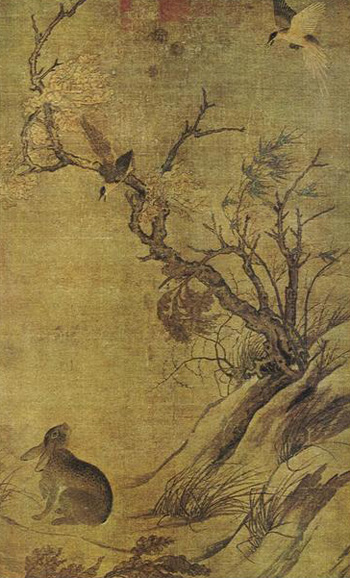 Among the upper class the availability of cheaper books enabled scholars to amass their own libraries. Song publishers printed the classics of Chinese literature in huge editions to satisfy scholarly appetites. Works on philosophy, science, and medicine also were avidly consumed, as were Buddhist texts. Han and Tang poetry and historical works became the models for the Song writers. One popular literary innovation was the encyclopedia, which first appeared in the Song period, at least five centuries before publication of a European encyclopedia. Link: Song Dynasty 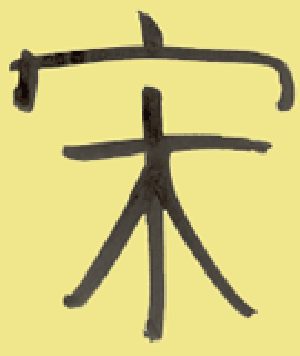 In 742 China's population was still approximately 50 million, very close to what it had been in 2 A.D. Over the next three centuries, with the expansion of rice cultivation in central and south China, the country's food supply steadily increased, and so did its population, which reached 100 million by 1100. China was certainly the largest country in the world at the time; its population probably exceeded that of all of Europe (as it has ever since). With the intensification of trade, merchants became progressively more specialized and organized. They set up partnerships and joint stock companies, with a separation of owners (shareholders) and managers. In the large cities merchants were organized into guilds according to the type of product sold, and they arranged sales from wholesalers to shop-owners and periodically set prices. When government officials wanted to requisition supplies or assess taxes, they dealt with the guild heads. Foreign trade also flourished in the Song period. In 1225 the superintendent of customs at the coastal city of Quanzhou wrote an account of the foreign places Chinese merchants visited. It includes sketches of major trading cities from Srivijaya to Malabar, Cairo, and Baghdad. Peals were said to come from the Persian Gulf, ivory from Aden, pepper from Java and Sumatra, and cotton from the various kingdoms of India. In this period Chinese ships began to displace Indian and Arab merchants in the South Seas. Ship design was improved in several ways. Watertight bulkheads improved buoyancy and protected cargo. Stern-mounted rudders improved steering. Some of these ships were powered by both oars and sails and large enough to hold several hundred men. 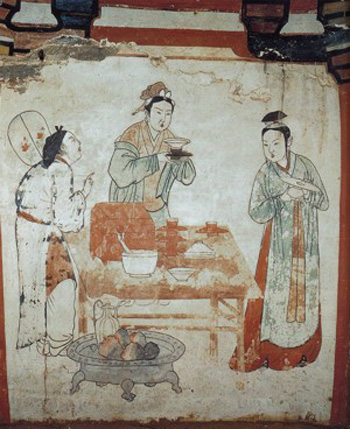 Also important to oceangoing travel was the perfection of the compass. The way a magnetic needle would point north had been known for some time, but in Song times the needle was reduced in size and attached to a fixed stem (rather than floating in water). In some cases it was put in a small protective case with a glass top, making it suitable for sea travel. The first reports of a compass used in this was date to 1119.. Ordinary people benefited from the Song economic revolution in many ways. There were more opportunities for the sons of farmers to leave agriculture and find work in cities. Those who stayed in agriculture had a better chance to improve their situations by taking up sideline production of wine, charcoal, paper, or textiles. Energetic farmers who grew cash crops such as sugar, tea, mulberry leaves (for silk), and cotton (recently introduced from India) could grow rich. Greater interregional trade let to the availability of more goods at the rural markets held every five to ten days. Of course not everyone grew rich. Poor farmers who fell into debt had to sell their land, and if they still owed money, they could be forced to sell their daughters as maids, concubines, or prostitutes. The prosperity of the cities created a huge demand for women to serve the rich in these ways, and Song sources mention that criminals would kidnap girls and women to sell in distant cities at huge profits. 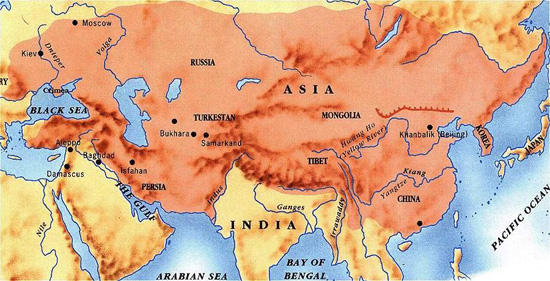 The earliest records of Mongol peoples occur in Chinese annals of the seventh century. At that time, the Mongols emerged onto the steppes of the central Asian land now called Mongolia, from the forests to the north, where they seem to have been hunters and small-scale pig breeders. On the steppes they adopted a pastoral way of life. They became horse-borne nomads and sheep herders. Chinese and Khitan writers used versions of the names "Mongols" and "Tatars" for many different communities, with various religions and competing leaderships. One thing they had in common was that they spoke languages of common origins that were different from those of the Turks. In the early twelfth century, the bands or alliances they formed got bigger, and their raids against neighboring sedentary peoples became more menacing. In part, this was the effect of the growing preponderance of some Mongol groups over others. In part, it was the result of slow economic change. 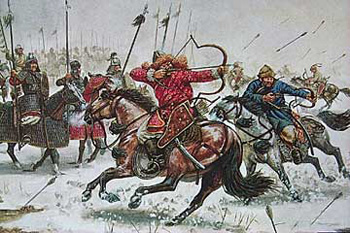 Contact with richer neighbors gave Mongol chiefs opportunities for enrichment as mercenaries or raiders. Economic inequalities greater than the Mongols had ever known arose in a society in which blood relationships and seniority in age had formerly settled every person's position. Prowess in war enabled particular leaders to build up followers in parallel with - and sometimes in defiance of - the old social order. They called this process "crane catching" - comparing it to caging valuable birds. The most successful leaders enticed or forced rival groups into submission. The process spread to involve peoples who were not strictly Mongols, though the same name continued to be used - we use it still - for a confederation of many peoples, including many who spoke Turkic languages. In 1206, Temujin , the most dynamic leader, proclaimed himself ruler (khan) "of all those who live in felt tents" - staking a claim to a steppe-wide empire. He was acclaimed by a title of obscure meaning, perhaps signifying "Ocean-King" and therefore, by implication, king of everything the ocean encloses. The title is traditionally rendered in the Roman alphabet as "Genghis Khan". 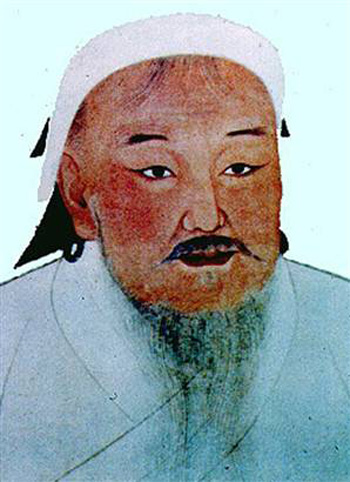 Genghis Khan Genghis Khan enforced or induced unity over almost the entire steppeland. The confederation of tribes he put together really did represent a combined effort of the steppe dwellers against the sedentary peoples who surrounded them. A single ideology came to animate, or perhaps reflect, that effort: the God-given terror-enforced right of the Mongols to conquer the world. The way events were recorded at the Mongol court in the next generation, it seemed as if from the moment of Genghis Khan's election as supreme ruler, "eternal heaven" had decreed that his conquests would encompass the world. The ruler is depicted as a constant devotee of Tengri - the sky, conceived as a supreme deity. The early Mongol-inspired sources constantly insist on an analogy between the over-arching unity of the sky and God's evident desire for the Earth to echo that unity through submission to one ruler. 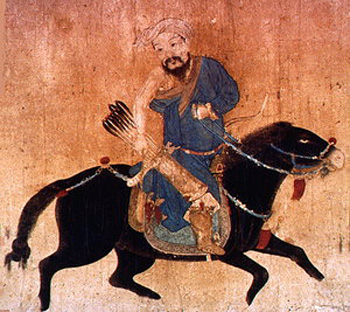 Above all, the Mongols were exceptionally adaptable warmongers. They triumphed not only in cavalry country, but also in environments where previous steppelander armies had failed, pressing into service huge forces of foot soldiers, mobilizing complex logistical support, organizing siege trains and fleets, appropriating the full potential of sedentary economies to finance further wards. The mountains of Georgia could not stop them. The Mongols captured the Georgian capital, Tbilisi, in 1234, turning Georgia into a puppet kingdom. Nor, in the long run, could the rice paddies and rivers of southern China where the Mongols destroyed the Song dynasty in the 1270s. Toward the end of the century, when another supreme khan wanted to conquer Java and Japan, they were even willing to take to the sea. But both attempts failed. As well as for the extent, the Mongol Empire was remarkable, by steppelander standards, for longevity. As his career progressed, Genghis Khan became a visionary lawgiver, a patron of letters, an architect of enduring empire. His first steps toward acquiring a bureaucracy and a judicial system more or less coincided with his election as khan. He then turned to lawmaking. Gradually, a code took shape, regulating hunting, army discipline, behavior at feasts, and social relationships, with death the penalty for murder, serious theft, conspiracy, adultery, sodomy, and witchcraft. Initially, the khan relied on uighurs for his administrators and ordered the adoption of the Uighur script for the Mongols' language. But he recruited as and where he conquered, without favoritism for any community or creed. His closest ministers included Muslims, Christians and Buddhists.
 When Charlemagne came to the throne in 768, it seemed possible that the frankish kingdom would break up into its hostile regional parts of Austrasia, Neustria, and Aquitaine. But in an astonishing series of military campaigns, Charlemagne united the Franks by leading them on a series of conquests that annexed the Lombard kingdom of Italy, the greater part of Germany including Saxony, portions of central Europe, and Catalunya. These conquests set a seal of divine approval on a new Carolingian dynasty. They also provided the plunder, booty, and new lands that enabled Charlemagne to promote his Frankish followers to dizzying heights of wealth and grandeur. Many of the peoples whom Charlemagne conquered were already Christians. Throughout his reign, Charlemagne took seriously his responsibilities as a Christian king. As his empire expanded, however, he came to see himself not only as the ruler of the Franks, but as the leader of a unified Christian society, Christendom, which he was obliged to defend both militarily and spiritually against its enemies. The Carolingian world did not make the distinctions between the religious and the political realms that would characterize European life from the twelfth century on. Among churchmen, kingship in early medieval Europe was regarded as a sacred office created by God to protect the church, defend the Christian people, and promote their salvation. As the dominant political power in central Italy, Charlemagne was also the protector of the papacy. Although carefully acknowledging the pope's role as the spiritual leader of western Christianity, Charlemagne dealt with the pope much as he did with the other bishops of the Frankish empire. The climax of Charlemagne's career came in Rome on Christmas Day 800, when he was crowned as the new Roman emperor in the West by Pope Leo III. Centuries later, popes would cite their role in this event as precedent for the political superiority they claimed over the Holy Roman emperor. 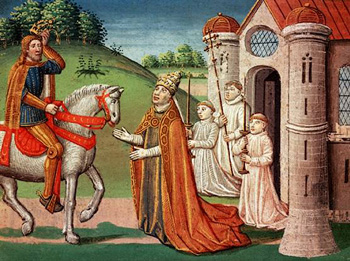 Until 800 only the Roman emperor who ruled in Constantinople could lay claim to being the direct heir of Caesar Augustus. Although the Byzantines had lost most of their influence in the West, they continued to regard it vaguely as an outlying province of their empire. Charlemagne's assumption of the imperial title was a clear slap in the face to the Byzantines, who were already suspicious of Charlemagne's relationship with Byzantium's enemy Harun a-Rashid, the Abbasid caliph in Baghdad. With only occasional interruptions, western Europeans would continue to crown Roman emperors until the nineteenth century, when Napoleon retired the title. Whatever his specific motives may have been, Charlemagne's revival of the western Roman empire proved to be a major step in the developing self-consciousness of western European civilization. Link: Charlemagne Charlemagne Info (under construction) The Middle Ages were characterized by a chronic absence of effective central government and the constant threat of famine, disease, and foreign invasion. In this state of affairs the weaker sought the protection of the stronger, and the true lords and masters became those who could guarantee immediate protection from rapine and starvation. The term feudal society refers to the social, political, military, and economic system that emerged from these conditions.  A feudal society is a social order in which a regional prince or a local lord is dominant, and the highest virtues are those of mutual trust and fidelity. In a feudal society, what people require most is the firm assurance that others can be depended on in time of dire need. It is above all a system of mutual rights and responsibilities. During the early Middle Ages, the landed nobility became great lords who ruled over their domains as miniature kingdoms. They maintained their own armies and courts, regulated local tolls, and even minted their own coins. Large groups of warrior vassals were created by extensive bestowals of land and these developed into a prominent professional military class with its own code of knightly conduct. In feudal society most serfs docilely worked the land, the clergy prayed and gave counsel, and lords and knights maintained law and order. Vassalage involved "fealty" to the lord. To swear fealty was to promise to refrain from any action that might in any way threaten the lord's well-being and to perform personal services for him on his request. Chief among the expected services was military duty as a mounted knight. This could involve a variety of activities: a short or long military expeditions, escort duty, standing castle guard, or the placement of one's own fortress at the lord's disposal, if the vassal was of such stature as to have one. Continuous bargaining and bickering occurred over the terms of service. Limitations were placed on the number of days a lord could require services from a vassal. In France in the eleventh century, about forty days of service per year were considered sufficient. It also became possible for vassals to buy their way out of military service by a monetary payment known as scutage. The lord, in turn, applied this payment to the hiring of mercenaries, who often proved more efficient than contract-conscious vassals. Beyond his military duty, the vassal was also expected to give the lord advice when he requested it and to sit as a member of his court when it was in session. Link: Feudal Society 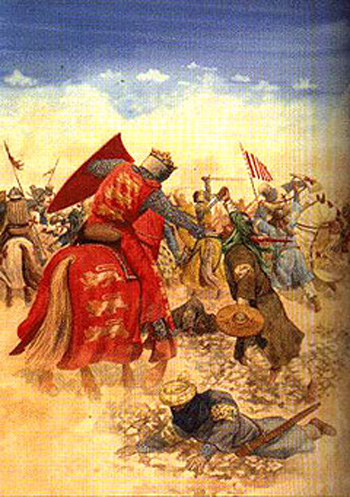 By the 1090's, Alexius Comnenus (Byzantine Emperor) had rebuilt the treasury, repulsed an attempted Norman invasion from southern Italy, restored Byzantine control over the Balkans, and was beginning to plan a campaign against the Turks. For more than a century, the Byzantine army had utilized western mercenaries in its armies. During the eleventh century, however, western knights had emerged as the most effective heavily armored cavalry troops in the world. Alexius had confronted such knights in 1085, when he repelled a Norman invasion of Greece. He was anxious to make use of them, however, against the mounted but lightly armored Turks. To recruit a force of heavy cavalry, Alexius sent a request to Pope Urban II, hoping for a contingent of a few thousand troops with which he might be able to roll back Turkish gains in Anatolia. Within a year, however, the pope had set in motion a vast crusading army of one hundred thousand Westerners to retake the Holy City of Jerusalem for Christendom. 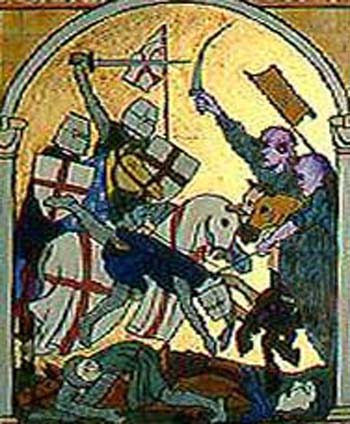 For Byzantium, the impact of the crusading movement was disastrous. The crusades coincided with, and to some extent caused, a decisive shift in the balance of economic and military power between Western Europe and the faltering Bzyantine empire. On the Islamic world, by contrast, the impact of the crusades was much more modest. Trade between Islam and the West continued despite periodic interruptions caused by crusader attacks on Syria, Egypt, and North Africa. The greatest economic gains went to the Italian maritime republics of Venice and Genoa; but Islamic merchants too came to depend increasingly upon western markets for their goods. Both sides also gained in military terms; westerners learned new techniques of fortification, and Muslims learned new methods of siege warfare and new respect of the uses of heavy cavalry. Finally, the crusades also helped to crystallize both Christian and Islamic doctrines of holy war against the infidel. Neither Christian holy war nor Muslim jihad drew much doctrinally from the other. The collision between them, however, deepened the mutual hostility that already separated the Islamic world and Christian Europe. Link: Medieval War Link: Knights Templar 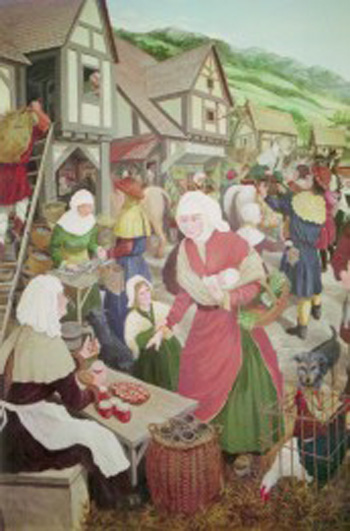 The High Middle Ages witnessed some of the most remarkable achievements in the entire history of Western society. Europeans displayed tremendous creativity and vitality in many realms of culture. Rulers tried to establish contact with all of their peoples, developed new legal and financial institutions, and slowly consolidated power in the hands of the monarchy. The kings of England and France succeeded in laying the foundations of the modern national state. The university, a uniquely Western contribution to civilization and a superb expression of medieval creativity, came into being at the same time. The Gothic cathedral manifested medieval peoples' deep Christian faith and their appreciation for the worlds of nature, man and God. The Crusades, a series of holy wars to recover the Holy Land from the Muslims, also expressed European Christians' strong, even fanatical, religious faith. 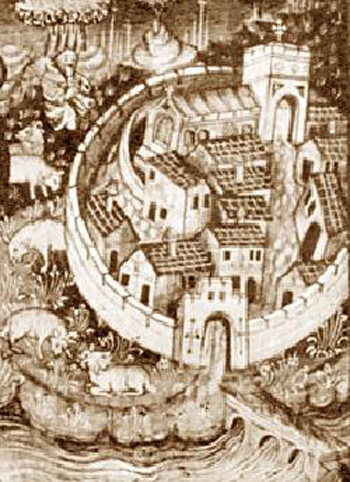 Towns were originally dominated by feudal lords, both lay and clerical. The lords created the towns by granting charters to those who would agree to live and work within them. The charters guaranteed the town's safety and gave their inhabitants a degree of independence unknown to peasants who worked the land. The purpose was originally to concentrate skilled laborers who could manufacture the finished goods desired by lords and bishops. As towns grew and beckoned, many serfs took their skills to the new urban centers. There they found the freedom and profits that could lift an industrious craftsperson into higher social ranks. As this migration of serfs to the towns accelerated, the lords in the countryside offered serfs more favorable terms of tenure to keep them on the land. The growth of towns thus improved the lot of serfs generally. Rural society not only gave the towns their craftspeople and day laborers, but the first merchants themselves may also have been enterprising serfs. Certainly, some of the long-distance traders were people who had nothing to lose and everything to gain from the enormous risks of foreign trade. They traveled together in armed caravans and convoys, buying goods and products as cheaply as possible at the source, and selling them for all they could get in western ports. At first the merchants were disliked because they were outside the traditional social groups of nobility, clergy, and peasantry. Over time, however, the powerful grew to respect the merchants, and the weak always tried to imitate them, because the merchants left a trail of wealth behind them. As the traders established themselves in towns, they grew in wealth and numbers, formed their own protective associations, and soon found themselves able to challenge traditional seigneurial authority. Merchants especially wanted to end the arbitrary tolls and tariffs regional magnates imposed over the surrounding countryside. Such regulations hampered the flow of commerce on which both merchant and craftsman in the growing urban export industries depended. Link: Medieval Brewing Link: Merchants 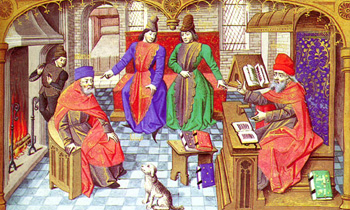 Universities, like Gothic cathedrals, are one of the enduring legacies of medieval civilization. It is appropriate that the University of Kent should enjoy the privilege of having its Degrees conferred in Canterbury Cathedral since not only were the earliest universities born out of the cathedral schools in twelfth-century Europe, but the earliest university Congregations assembled within churches. In medieval Oxford, the Great Congregation or university parliament met to confer Degrees and transact other academic business in the church of St Mary on the High Street. The earliest university chancellors were the agents of the bishops in whose dioceses the universities were located, and the degree which the chancellor awarded was essentially a license to teach as master of a school. Oxford's chancellor was the representative of the bishop of Lincoln, while the University of Paris was under the control of the chancellor of Notre Dame. 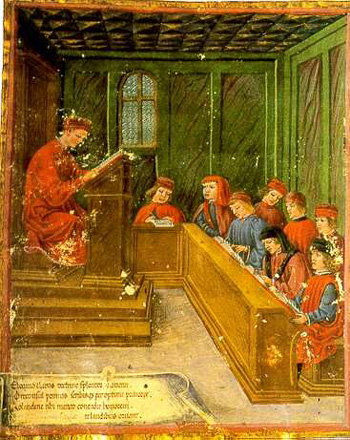 The word University seems to have been applied for the first time to the University of Paris in the thirteenth century. The Latin universitas, from which our modern word derives, originally referred to the guilds of masters and students but was applied also in a general sense to other corporations and communities of a non-academic nature. The earliest word for a university as an institution of higher learning, attended by students from distant parts, and adorned by scholars of distinction, was studium generale. The earliest of these studia grew up at Salerno, Bologna and Paris in the twelfth century, while, in England, Oxford was firmly established by 1170, with Cambridge starting life somewhat later around 1200. Universities in every age were founded and developed in response to major religious, social, and economic needs of their time. In the twelfth century they were born out of a rapidly expanding field of knowledge in medicine (Salerno), law (Bologna) and scholasticism (Paris), while their origin owed much, too, to the rapid expansion of urban life throughout late medieval Europe as well as to the political and religious turmoil of the age. Link: Universities High Middle Ages Link: English University Life 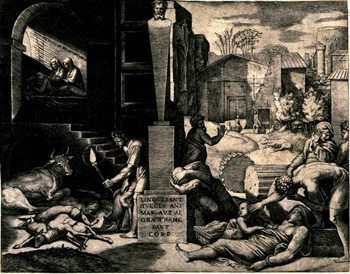 In the late Middle Ages, nine tenths of the population worked the land. The three-field system, in use in most areas since well before the fourteenth century, had increased the amount of arable land and thereby increased the food supply. The growth of cities and trade had also stimulated agricultural science and productivity. But as the good supply grew, so did the population. It is estimated that Europe's population doubled between the years 1000 and 1300, and then began to outstrip food production. There were now more people than food to feed them or jobs to employ them, and the average European faced the probability of famine at least once during his or her expected thirty-five year life span. Between 1315 and 1317 crop failures produced the greatest famine of the Middle Ages. Densely populated urban areas like the industrial towns of the Netherlands suffered greatly. Decades of overpopulation, economic depression, famine, and bad health made Europe's population highly vulnerable to a virulent bubonic plague that struck with full force in 1348. 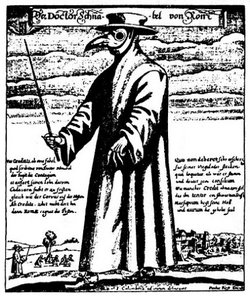 This Black Death, so called because it discolored the body, followed the trade routes from Asia into Europe. Appearing in Sicily in late 1347, it entered Europe through Venice, Genoa, and Pisa in 1348, and from there it swept rapidly through Spain and southern France and into northern Europe. Bubonic plague reappeared in succeeding decades. By the early fifteenth century, it may have killed two fifths of western Europe's population. The plague, transmitted by rat - or human-borne fleas, often reached a victim's lungs, from which it could be spread from person to person by sneezing and wheezing. Physicians had no understanding of these processes, and thus lacked even the most rudimentary prophylasxis against the disease. To contemporaries the Black Death was a catastrophe with no apparent explanation and against which there was no defense. Throughout much of western Europe, it inspired an obsession with death and dying and a deep and enduring pessimism. 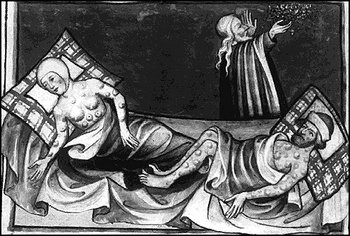 Popular wisdom held that a corruption in the atmosphere caused the disease. Some blamed poisonous fumes released by earthquakes. Many adopted aromatic amulets as a remedy. According to the contemporary observations of Giovanni Boccaccio (1313 - 1375), some sought a remedy in moderation and a temperate life; others gave themselves over entirely to their passions (sexual promiscuity within the stricken areas apparently ran high); and still others, "the most sound, perhaps, in judgment," chose flight and seclusion as the best medicine. Among the most extreme social reactions were processions of flagellants. These fanatics beat themselves in ritual penance until they bled, believing that such action would bring divine intervention. The flagellants, whose dirty bodies may have actually helped spread the disease, created a terror that became so socially disruptive and threatening even to established authority that the church finally outlawed such processions. Jews were cast as scapegoats for the plague. Centuries of Christian propaganda had bred hatred toward them, as had their willing role as society's moneylenders. Pogroms (extensive violence against Jews) occurred in several cities, sometimes incited by the arrival of flagellants. Link: Black Death Link: Black Death by Wikipedia |